Palm KITT PDA Phone with GSM/GPRS/EDGE/WCDMA and Bluetooth User Manual 1 of 4
Palm Inc PDA Phone with GSM/GPRS/EDGE/WCDMA and Bluetooth 1 of 4
Palm >
Contents
- 1. User Manual 1 of 4
- 2. User Manual 2 of 4
- 3. User Manual 3 of 4
- 4. User Manual 4 of 4
- 5. User Manaul 4 of 4
User Manual 1 of 4

Your Palm
®
Treo
™
750v Smartphone

Intellectual property notices
© 2006 Palm Inc. All rights reserved. Palm, Treo, and the Palm and
Treo logos are among the trademarks or registered trademarks
owned by or licensed to Palm Inc. All other brand and product names
are or may be trademarks of, and are used to identify products or
services of, their respective owners.
The Treo trademark is used by Palm Inc. in Sweden and Denmark
with the express consent of Pfizer and its affiliated companies. The
products marketed and/or sold by Palm Inc. under the Treo trademark
are in no way affiliated with Pfizer or its business.
This product is protected by one or more of the following United
States patents:
7,007,239; 6,976,226; 6,975,304; 6,965,375; 6,961,567; 6,961,029;
6,957,397; 6,952,571; 6,950,988; 6,947,975; 6,947,017; 6,943,667;
6,940,490; 6,924,752; 6,907,233; 6,906,701; 6,906,741; 6,901,276;
6,850,780; 6,845,408; 6,842,628; 6,842,335; 6,831,662; 6,819,552;
6,804,699; 6,795,710; 6,788,285; 6,781,824; 6,781,575; 6,766,490;
6,745,047; 6,744,451; 6,738,852; 6,732,105; 6,724,720; 6,721,892;
6,712,638; 6,708,280; 6,697,639; 6,687,839; 6,685,328; 6,665,803;
6,618,044; 6,590,588; 6,539,476; 6,532,148;6,523,124; 6,519,141;
6,516,202; 6,490,155; 6,480,146; 6,457,134; 6,456,247; 6,442,637;
6,441,824; 6,437,543; 6,429,625; 6,425,087; 6,389,572; 6,388,877;
6,381,650; 6,363,082; 6,344,848; 6,317,085; 6,241,537; 6,222,857;
6,185,423; 6,147,314; 6,115,248; 6,064,342; D421,251; D429,252;
D466,128; D478,091. Patent pending.
This product also is licensed under United States patent 6,058,304.
MPEG Layer-3 audio decoding technology is licensed from Fraunhofer
IIS and Thomson. Palm, Inc. is an authorized licensee of the
MultiMediaCard trademark. This product is protected by certain
intellectual property rights of Microsoft Corporation. Use or
distribution of such technology outside of this product is prohibited
without a license from Microsoft or an authorized Microsoft
subsidiary. All rights reserved.
Disclaimer and limitation of liability
Palm Inc. and its suppliers assume no responsibility for any damage
or loss resulting from the use of this guide. Palm Inc. and its suppliers
assume no responsibility for any loss or claims by third parties that
may arise through the use of this software. Palm Inc. and its suppliers
assume no responsibility for any damage or loss caused by deletion
of data as a result of malfunction, dead battery, or repairs. Be sure to
make backup copies of all important data on other media to protect
against data loss.
End user notice
NOTE The Voice Command application is not available in all
languages. See Setting up voice commands .
Microsoft® Voice Command Version 1.5 for Windows Mobile®
IMPORTANT Do not become distracted from driving safely if
operating a motor vehicle while using Device Software.
Operating certain parts of this Device requires user attention.
Diverting attention away from the road while driving can possibly
cause an accident or other serious consequences. Even occasional,
short diversions of attention can be dangerous if your attention is
diverted away from your driving task at a critical time. Do not change
system settings or enter data non-verbally (using your hands) while
driving. Stop the vehicle in a safe and legal manner before attempting
these operations. This is important since while setting up or changing
some functions you might be required to distract your attention away
from the road and remove your hands from the wheel.
Microsoft makes no representations, warranties, or other
determinations that ANY use of the Software Product is legal, safe, or
in any manner recommended or intended while driving or otherwise
operating a motor vehicle.
General Operation
NOTE The Voice Command application is not available in all
languages. See Setting up voice commands .
Voice Command Control: Many of the functions of the Device
Software can be accomplished using only voice commands. Using
voice commands while driving allows you to initiate the command
with a button and then operate the Device mostly without removing
your hands from the wheel.

Prolonged Views of Screen: If you are driving, do not access any
function requiring a prolonged view of the screen. Pull over in a safe
and legal manner before attempting to access a function of the
system requiring prolonged attention. Even occasional short scans to
the screen may be hazardous if your attention has been diverted
away from your driving task at a critical time.
Volume Setting: Do not raise the volume excessively. Keep the
volume at a level where you can still hear outside traffic and
emergency signals while driving. Driving while unable to hear these
sounds could cause an accident.
Let Your Judgment Prevail: The Device Software is only an aid.
Make your driving decisions based on your observations of local
conditions and existing traffic regulations. The Device Software is not
a substitute for your personal judgment.
Use of Speech Recognition Functions: Speech recognition
software is inherently a statistical process which is subject to errors.
It is your responsibility to monitor the speech recognition functions
and address any errors.
PN: 406-10620-00
v 1.1


CONTENTS v
Contents
Welcome . . . . . . . . . . . . . . . . . . . . . . . . . . . . . . . . . . . . . . . . . . . . . . . . . . . . . . . . . . . 1
What’s in the box? . . . . . . . . . . . . . . . . . . . . . . . . . . . . . . . . . . . . . . . . . . . . . . . . . . 1
What do I need to get started? . . . . . . . . . . . . . . . . . . . . . . . . . . . . . . . . . . . . . . . . 2
Chapter 1: Setting up . . . . . . . . . . . . . . . . . . . . . . . . . . . . . . . . . . . . . . . . . . . . . . . . . . 3
Palm Treo 750v smartphone overview . . . . . . . . . . . . . . . . . . . . . . . . . . . . . . . . . . . 5
Inserting the SIM card and battery . . . . . . . . . . . . . . . . . . . . . . . . . . . . . . . . . . . . . . 8
Charging the battery . . . . . . . . . . . . . . . . . . . . . . . . . . . . . . . . . . . . . . . . . . . . . . . . . 9
Making your first call . . . . . . . . . . . . . . . . . . . . . . . . . . . . . . . . . . . . . . . . . . . . . . . . 12
Setting up synchronization . . . . . . . . . . . . . . . . . . . . . . . . . . . . . . . . . . . . . . . . . . . . 14
Chapter 2: Moving around on your smartphone . . . . . . . . . . . . . . . . . . . . . . . . . . . . . . 15
Navigating around the screen . . . . . . . . . . . . . . . . . . . . . . . . . . . . . . . . . . . . . . . . . . 17
Using the keyboard . . . . . . . . . . . . . . . . . . . . . . . . . . . . . . . . . . . . . . . . . . . . . . . . . 24
Opening and closing applications . . . . . . . . . . . . . . . . . . . . . . . . . . . . . . . . . . . . . . . 28
Using your Today screen . . . . . . . . . . . . . . . . . . . . . . . . . . . . . . . . . . . . . . . . . . . . . 29
Chapter 3: Your phone . . . . . . . . . . . . . . . . . . . . . . . . . . . . . . . . . . . . . . . . . . . . . . . . . 31
Turning your smartphone on/off . . . . . . . . . . . . . . . . . . . . . . . . . . . . . . . . . . . . . . . .33
Making calls from the Today screen . . . . . . . . . . . . . . . . . . . . . . . . . . . . . . . . . . . . 34
Other ways of making calls . . . . . . . . . . . . . . . . . . . . . . . . . . . . . . . . . . . . . . . . . . . 38
Receiving calls . . . . . . . . . . . . . . . . . . . . . . . . . . . . . . . . . . . . . . . . . . . . . . . . . . . . . 39
Using voicemail . . . . . . . . . . . . . . . . . . . . . . . . . . . . . . . . . . . . . . . . . . . . . . . . . . . . 40
What can I do during a call? . . . . . . . . . . . . . . . . . . . . . . . . . . . . . . . . . . . . . . . . . . . 41
How many minutes have I used? . . . . . . . . . . . . . . . . . . . . . . . . . . . . . . . . . . . . . . . 47
Defining speed-dial buttons . . . . . . . . . . . . . . . . . . . . . . . . . . . . . . . . . . . . . . . . . . . 47
Using a phone headset . . . . . . . . . . . . . . . . . . . . . . . . . . . . . . . . . . . . . . . . . . . . . . . 50

CONTENTS
vi
Customizing phone settings . . . . . . . . . . . . . . . . . . . . . . . . . . . . . . . . . . . . . . . . . . . 54
What are all those icons? . . . . . . . . . . . . . . . . . . . . . . . . . . . . . . . . . . . . . . . . . . . . . 62
Chapter 4: Synchronizing information . . . . . . . . . . . . . . . . . . . . . . . . . . . . . . . . . . . . . 65
How do I synchronize? . . . . . . . . . . . . . . . . . . . . . . . . . . . . . . . . . . . . . . . . . . . . . . . 68
What can I synchronize? . . . . . . . . . . . . . . . . . . . . . . . . . . . . . . . . . . . . . . . . . . . . . 69
Setting up wireless synchronization . . . . . . . . . . . . . . . . . . . . . . . . . . . . . . . . . . . . . 70
Setting up your computer for synchronization . . . . . . . . . . . . . . . . . . . . . . . . . . . . . 74
Synchronizing using the sync cable . . . . . . . . . . . . . . . . . . . . . . . . . . . . . . . . . . . . . 78
Other ways to synchronize . . . . . . . . . . . . . . . . . . . . . . . . . . . . . . . . . . . . . . . . . . . 79
Setting synchronization options . . . . . . . . . . . . . . . . . . . . . . . . . . . . . . . . . . . . . . . . 81
Chapter 5: Your email . . . . . . . . . . . . . . . . . . . . . . . . . . . . . . . . . . . . . . . . . . . . . . . . . . 83
Setting up . . . . . . . . . . . . . . . . . . . . . . . . . . . . . . . . . . . . . . . . . . . . . . . . . . . . . . . . . 85
Sending and receiving messages . . . . . . . . . . . . . . . . . . . . . . . . . . . . . . . . . . . . . . . 89
Working with email messages . . . . . . . . . . . . . . . . . . . . . . . . . . . . . . . . . . . . . . . . . 93
Sending email messages from within another application . . . . . . . . . . . . . . . . . . . . 97
Chapter 6: Your text and multimedia messages . . . . . . . . . . . . . . . . . . . . . . . . . . . . . 99
Using the Messaging application . . . . . . . . . . . . . . . . . . . . . . . . . . . . . . . . . . . . . . . 101
Customizing the Messaging application . . . . . . . . . . . . . . . . . . . . . . . . . . . . . . . . . . 110
Chapter 7: Your connections to the web and wireless devices . . . . . . . . . . . . . . . . . . 113
Browsing the web . . . . . . . . . . . . . . . . . . . . . . . . . . . . . . . . . . . . . . . . . . . . . . . . . . 115
Connecting to devices with Bluetooth® wireless technology . . . . . . . . . . . . . . . . . 121
Using your device as a wireless modem . . . . . . . . . . . . . . . . . . . . . . . . . . . . . . . . . 125
Chapter 8: Your photos, videos, and music . . . . . . . . . . . . . . . . . . . . . . . . . . . . . . . . . 129
Camera . . . . . . . . . . . . . . . . . . . . . . . . . . . . . . . . . . . . . . . . . . . . . . . . . . . . . . . . . . . 131
Pictures & Videos . . . . . . . . . . . . . . . . . . . . . . . . . . . . . . . . . . . . . . . . . . . . . . . . . . . 136
Windows Media Player Mobile . . . . . . . . . . . . . . . . . . . . . . . . . . . . . . . . . . . . . . . . 140

CONTENTS vii
Chapter 9: Your personal information organizer . . . . . . . . . . . . . . . . . . . . . . . . . . . . . . 147
Contacts . . . . . . . . . . . . . . . . . . . . . . . . . . . . . . . . . . . . . . . . . . . . . . . . . . . . . . . . . . 149
Calendar . . . . . . . . . . . . . . . . . . . . . . . . . . . . . . . . . . . . . . . . . . . . . . . . . . . . . . . . . . 151
Tasks . . . . . . . . . . . . . . . . . . . . . . . . . . . . . . . . . . . . . . . . . . . . . . . . . . . . . . . . . . . . 157
Notes . . . . . . . . . . . . . . . . . . . . . . . . . . . . . . . . . . . . . . . . . . . . . . . . . . . . . . . . . . . . 159
Chapter 10: Your Microsoft Office tools . . . . . . . . . . . . . . . . . . . . . . . . . . . . . . . . . . . 163
Synchronizing your Microsoft Office files . . . . . . . . . . . . . . . . . . . . . . . . . . . . . . . . 165
Word Mobile . . . . . . . . . . . . . . . . . . . . . . . . . . . . . . . . . . . . . . . . . . . . . . . . . . . . . . . 165
PowerPoint Mobile . . . . . . . . . . . . . . . . . . . . . . . . . . . . . . . . . . . . . . . . . . . . . . . . . . 171
Excel Mobile . . . . . . . . . . . . . . . . . . . . . . . . . . . . . . . . . . . . . . . . . . . . . . . . . . . . . . . 172
Chapter 11: Your application and info management tools . . . . . . . . . . . . . . . . . . . . . . 183
Finding information . . . . . . . . . . . . . . . . . . . . . . . . . . . . . . . . . . . . . . . . . . . . . . . . . . 185
Installing applications . . . . . . . . . . . . . . . . . . . . . . . . . . . . . . . . . . . . . . . . . . . . . . . . 187
Removing applications . . . . . . . . . . . . . . . . . . . . . . . . . . . . . . . . . . . . . . . . . . . . . . . 190
Sharing information . . . . . . . . . . . . . . . . . . . . . . . . . . . . . . . . . . . . . . . . . . . . . . . . . 191
Beaming information . . . . . . . . . . . . . . . . . . . . . . . . . . . . . . . . . . . . . . . . . . . . . . . . 191
Using expansion cards . . . . . . . . . . . . . . . . . . . . . . . . . . . . . . . . . . . . . . . . . . . . . . . 193
Calculator . . . . . . . . . . . . . . . . . . . . . . . . . . . . . . . . . . . . . . . . . . . . . . . . . . . . . . . . . 197
Chapter 12: Your personal settings . . . . . . . . . . . . . . . . . . . . . . . . . . . . . . . . . . . . . . .199
Today screen settings . . . . . . . . . . . . . . . . . . . . . . . . . . . . . . . . . . . . . . . . . . . . . . . 201
System sound settings . . . . . . . . . . . . . . . . . . . . . . . . . . . . . . . . . . . . . . . . . . . . . . . 202
Display and appearance settings . . . . . . . . . . . . . . . . . . . . . . . . . . . . . . . . . . . . . . . 204
Application settings . . . . . . . . . . . . . . . . . . . . . . . . . . . . . . . . . . . . . . . . . . . . . . . . .206
Locking your smartphone and info . . . . . . . . . . . . . . . . . . . . . . . . . . . . . . . . . . . . . . 210
System settings . . . . . . . . . . . . . . . . . . . . . . . . . . . . . . . . . . . . . . . . . . . . . . . . . . . . 214
Connection settings . . . . . . . . . . . . . . . . . . . . . . . . . . . . . . . . . . . . . . . . . . . . . . . . . 220

CONTENTS
viii
Chapter 13: Common questions . . . . . . . . . . . . . . . . . . . . . . . . . . . . . . . . . . . . . . . . . 223
Transferring info from another device . . . . . . . . . . . . . . . . . . . . . . . . . . . . . . . . . . . 223
Reinstalling the desktop software . . . . . . . . . . . . . . . . . . . . . . . . . . . . . . . . . . . . . . 224
Resetting your smartphone . . . . . . . . . . . . . . . . . . . . . . . . . . . . . . . . . . . . . . . . . . . 224
Performance . . . . . . . . . . . . . . . . . . . . . . . . . . . . . . . . . . . . . . . . . . . . . . . . . . . . . . . 228
Screen . . . . . . . . . . . . . . . . . . . . . . . . . . . . . . . . . . . . . . . . . . . . . . . . . . . . . . . . . . . 229
Network connection . . . . . . . . . . . . . . . . . . . . . . . . . . . . . . . . . . . . . . . . . . . . . . . . . 229
Synchronization . . . . . . . . . . . . . . . . . . . . . . . . . . . . . . . . . . . . . . . . . . . . . . . . . . . . 233
Email . . . . . . . . . . . . . . . . . . . . . . . . . . . . . . . . . . . . . . . . . . . . . . . . . . . . . . . . . . . . 239
Web . . . . . . . . . . . . . . . . . . . . . . . . . . . . . . . . . . . . . . . . . . . . . . . . . . . . . . . . . . . . . 241
Camera . . . . . . . . . . . . . . . . . . . . . . . . . . . . . . . . . . . . . . . . . . . . . . . . . . . . . . . . . . . 242
Third-party applications . . . . . . . . . . . . . . . . . . . . . . . . . . . . . . . . . . . . . . . . . . . . . . 243
Making room on your smartphone . . . . . . . . . . . . . . . . . . . . . . . . . . . . . . . . . . . . . . 244
Voice quality . . . . . . . . . . . . . . . . . . . . . . . . . . . . . . . . . . . . . . . . . . . . . . . . . . . . . . . 245
Where to learn more . . . . . . . . . . . . . . . . . . . . . . . . . . . . . . . . . . . . . . . . . . . . . . . . . . 247
Terms . . . . . . . . . . . . . . . . . . . . . . . . . . . . . . . . . . . . . . . . . . . . . . . . . . . . . . . . . . . . . . 249
Regulatory information . . . . . . . . . . . . . . . . . . . . . . . . . . . . . . . . . . . . . . . . . . . . . . . . . 255
Specifications . . . . . . . . . . . . . . . . . . . . . . . . . . . . . . . . . . . . . . . . . . . . . . . . . . . . . . . . 263
Index . . . . . . . . . . . . . . . . . . . . . . . . . . . . . . . . . . . . . . . . . . . . . . . . . . . . . . . . . . . . . . 267

WHAT’S IN THE BOX? 1
Welcome
Congratulations on the purchase of your
Palm® Treo™ 750v smartphone. In one
compact and indispensable device, you
now have all of the following:
•An advanced wireless smartphone
•A Windows Mobile® organizer with
portable expansion capability (miniSD)
•High-speed data with GPRS/EDGE and
UMTS support
•A 1.3-megapixel digital camera Support
for numerous mobile email solutions
•Text and multimedia messaging
•Windows Media® Player Mobile
•Microsoft® Office Mobile suite
This guide will help you set up your Treo
750v smartphone and quickly learn to
use it.
NOTE If you want to use your phone and
send and receive text messages, you need
a service contract with your network
operator. If you also want to browse the
web and send and receive email, you need
not only a service contract but also
high-speed data service from your network
operator. You may also need high-speed
data service to send and receive
multimedia messages. Data speeds vary
based on network availability and capacity.
What’s in the box?
You should have received all of the
following items in the Treo 750v
smartphone box:
Hardware
•Treo 750v smartphone
•Rechargeable battery (1200 mAh)
•AC charger with international adapters
•USB sync cable
•Stereo headset
•Screen protector
TIP
LOOK HERE: Don’t miss the helpful tips
and cross-references given in this column.

WHAT DO I NEED TO GET STARTED?
2
Documentation and software
•Quick Start Guide
•Treo 750v Smartphone Quick Reference
Guide
•Windows Mobile Getting Started Disc,
which includes the following:
•Microsoft Office Outlook® software for
your computer
•ActiveSync® desktop synchronization
software
•Additional software for your
smartphone
•User Guide (this guide)
•Palm warranty
•End User License Agreement
What do I need to
get started?
As you work through the instructions in this
guide, you need all the items that came in
the Treo 750v smartphone box (see What’s
in the box?) as well as the following:
•An activated wireless account (using a
SIM card) with data services
•A location with wireless coverage for
your smartphone
•If you plan to synchronize personal
information between your smartphone
and a computer, you need access to
that computer during setup.

CHAPTER
1
Setting up
Congratulations on the purchase of your new Palm® Treo™ 750v
smartphone. You’re about to discover the many things about
your smartphone that will help you better manage your life and
have fun, too.
As you become more familiar with your smartphone, you’ll
want to personalize the settings and add applications to make it
uniquely yours. But first, take these few easy steps to set up
your smartphone and get it running.
Benefits
•Know where your smartphone
controls are located
•Start using your smartphone right
away

In this chapter
Palm Treo 750v smartphone overview. . . . . . . . . . . . . . . . . . . . . . . 5
Inserting the SIM card and battery. . . . . . . . . . . . . . . . . . . . . . . . . . 8
Making your first call . . . . . . . . . . . . . . . . . . . . . . . . . . . . . . . . . . . . 12
Setting up synchronization . . . . . . . . . . . . . . . . . . . . . . . . . . . . . . . . 14
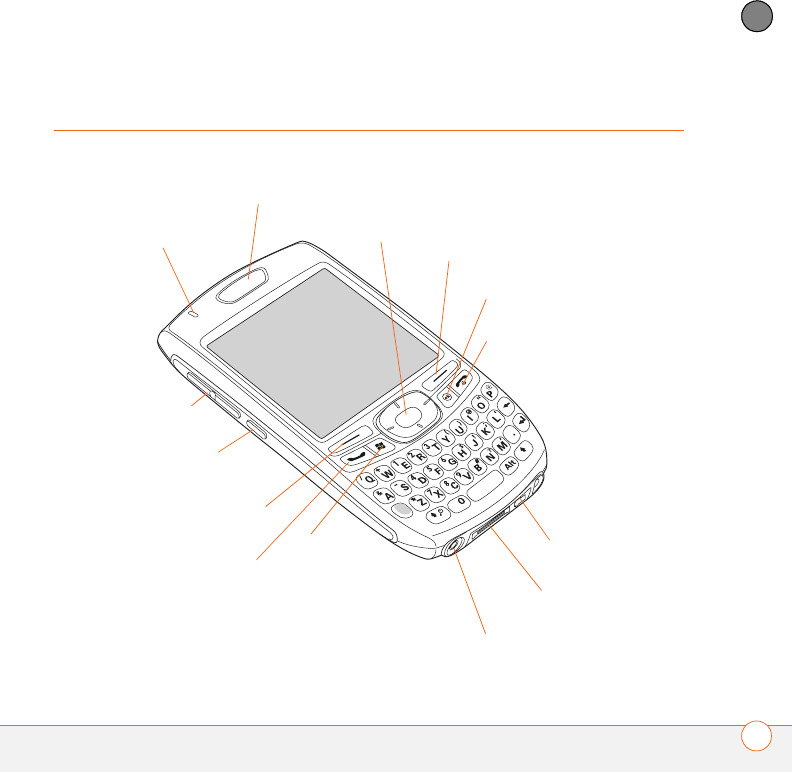
SETTING UP
PALM TREO 750V SMARTPHONE OVERVIEW 5
1
CHAPTER
Palm Treo 750v smartphone overview
Front view
Indicator light (phone
and charge indicator)
Multi-connector
5-way navigator
with Center button
Earpiece
Power/End
Microphone
Headset jack
Start
Phone/Send
Side button
OK
Volume
Left action
key
Right action key
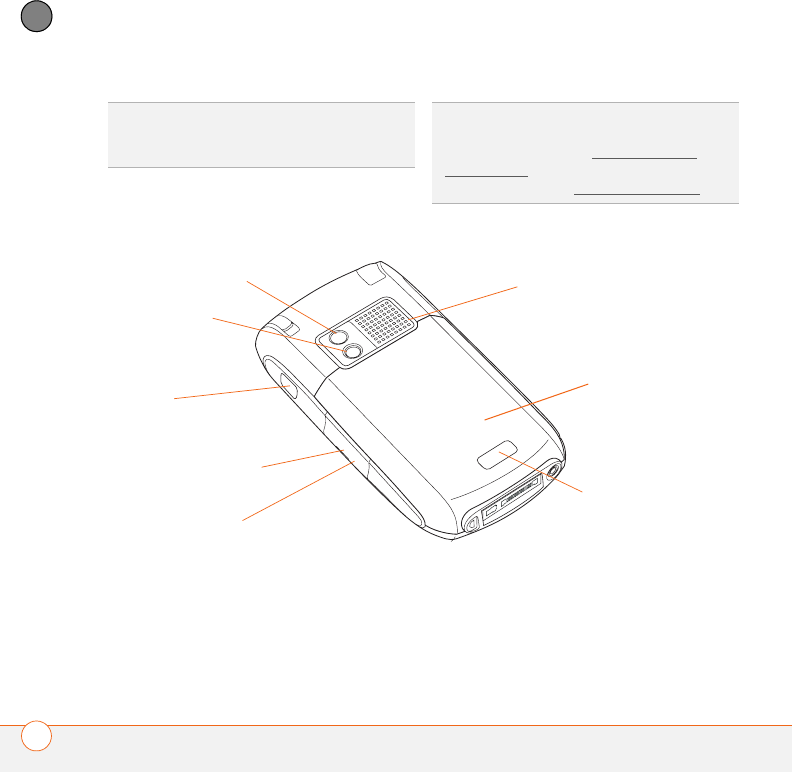
SETTING UP
PALM TREO 750V SMARTPHONE OVERVIEW
6
1
CHAPTER
Back view
TIP
Be careful not to scratch or crush your
smartphone screen. Do not store it in a place
where other items might damage it.
DID
YOU
KNOW
?
By default, pressing the Side
button opens the Windows Media® Player
Mobile application (see Windows Media
Player Mobile). You can change the function of
the Side button (see Reassigning buttons).
Camera lens
Speaker
Self-portrait mirror
Infrared (IR)
port
Expansion card
slot
Reset button
(located inside
expansion card
slot door)
Battery door
release
SIM card slot
(located inside
battery
compartment,
beneath battery)
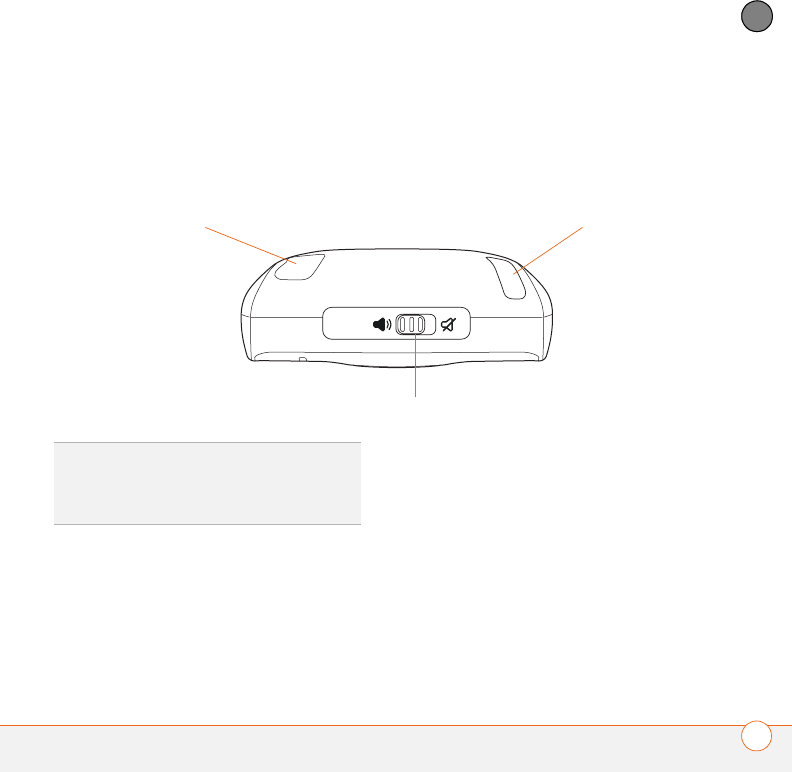
SETTING UP
PALM TREO 750V SMARTPHONE OVERVIEW 7
1
CHAPTER
IMPORTANT The Treo 750v smartphone
speaker includes a large magnet, so be
sure not to store your smartphone near
credit cards or other items that could be
demagnetized.
Top view
Ringer switch
Stylus
External antenna
connector
DID
YOU
KNOW
?
The Ringer switch silences all
sounds, including music, at once; you don’t
need to hunt for “off” or “mute” settings in
individual applications.
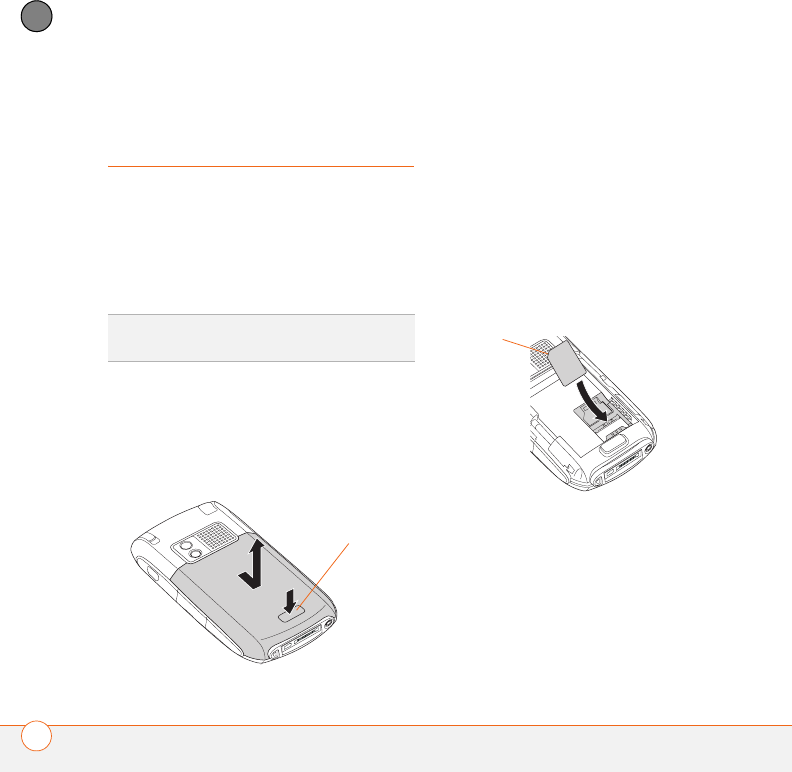
SETTING UP
INSERTING THE SIM CARD AND BATTERY
8
1
CHAPTER
Inserting the SIM
card and battery
To use your smartphone’s phone, email, or
web features, you need to insert a SIM
card. If a SIM card is not included in your
smartphone box, your network operator
will provide you with one.
1Use one hand to press the Battery
door release button, and use your other
hand to slide the battery door
downward to remove it from your
smartphone.
2If the battery is installed, remove it.
Slide your finger under the left side of
the battery (nearest the stylus) and lift
up to remove.
3With the metal contacts facing the
battery compartment, slide the SIM
card into the cutout in the lower-right
corner of the compartment until you
feel it snap into place. Align the notches
to make sure you have the card oriented
correctly.
4Align the metal contacts on the battery
with the contacts inside the battery
compartment, insert the battery into the
compartment at a 45-degree angle, and
then press it into place.
TIP
If you don’t have a SIM card, contact your
network operator.
Battery door
release button
Notch
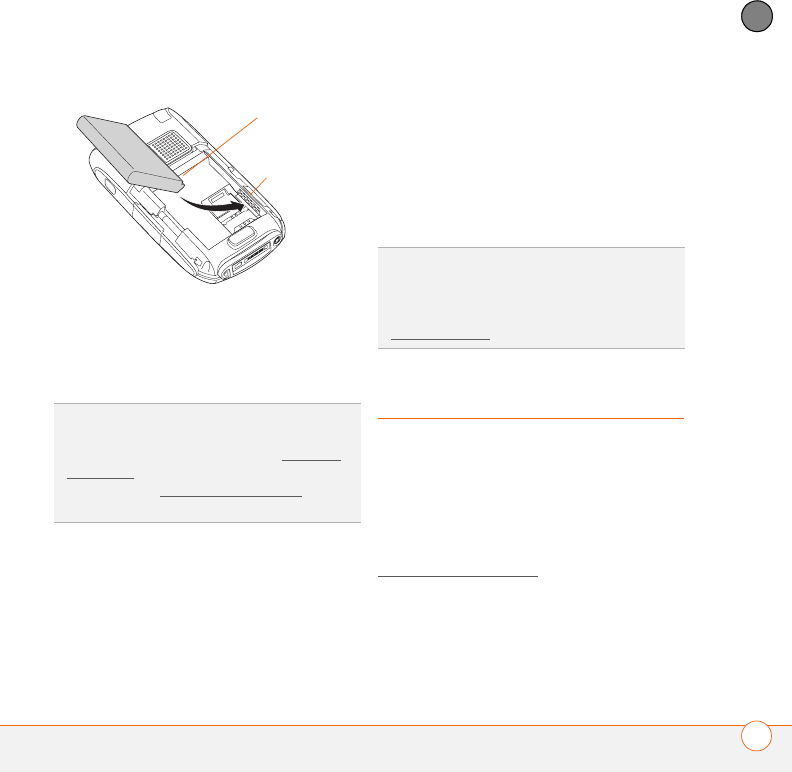
SETTING UP
CHARGING THE BATTERY 9
1
CHAPTER
5Slide the battery door back into place.
Your smartphone screen turns on.
Wait for the progress bar to fill and the
Windows Mobile® screen to appear.
6Follow the onscreen instructions to
finish the installation.
7If your SIM card is not already activated,
follow the activation steps provided by
your network operator, or contact your
network operator directly for
assistance. If you plan to use email and
web browsing, you need high-speed
data service from your network
operator in addition to your service
contract. You may also need high-speed
data service to send and receive
multimedia messages.
Charging the battery
Although the battery may come with a
sufficient charge to complete the setup
process, we recommend that after setup
you charge your smartphone for three
hours (or until the indicator light is solid
green) to give it a full charge. See
Maximizing battery life for tips on making
your battery’s power last longer.
BEFORE YOU BEGIN Make sure the
battery is inserted before you charge. If you
connect your smartphone to a power
TIP
If your smartphone does not turn on after
you insert the battery, you need to connect it
to the AC charger to charge it; see Charging
the battery. If it still doesn’t start, perform a
soft reset; see Performing a soft reset for
information.
Battery
contacts
Compartment
contacts
TIP
You can buy an extra battery as a spare for
long airplane trips or periods of heavy data
use. To ensure proper functioning, be sure to
use batteries from Palm only. Visit
www.palm.com.
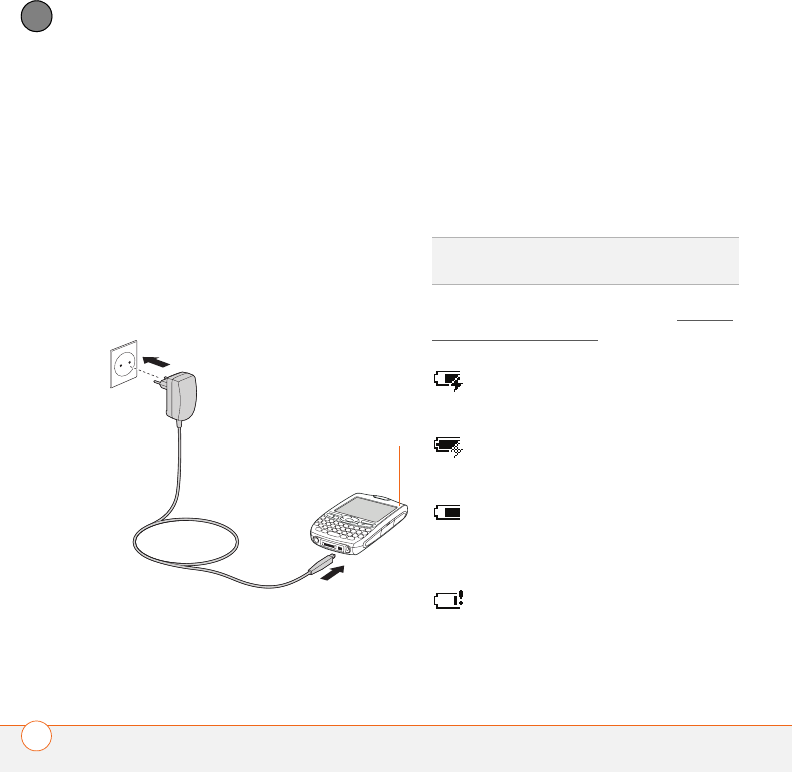
SETTING UP
CHARGING THE BATTERY
10
1
CHAPTER
source without the battery inserted,
nothing happens.
1Prepare the AC charger by inserting the
adapter that fits the wall outlet you’re
going to use.
2Plug the AC charger into a wall outlet.
3With the arrow on the connector facing
up (toward your smartphone screen),
connect the charger cable to the bottom
of your smartphone.
4Check the indicator light to confirm that
your smartphone is being charged.
•Solid red indicates that your
smartphone is being charged.
•Solid green indicates that your
smartphone is fully charged.
When your smartphone is on (see Turning
your smartphone on/off), the onscreen
battery icon displays the charging status:
Indicator light
DID
YOU
KNOW
?
If the battery is low, the
indicator light flashes red.
A solid lightning bolt indicates that
the battery is connected to a wall
outlet and is charging.
A shaded lightning bolt indicates
that the battery is connected to a
wall outlet and is fully charged.
A partial battery without a lightning
bolt indicates that the battery is not
connected to a wall outlet and that
it has some power.
An exclamation point (!) indicates
that the battery needs to be
charged immediately.
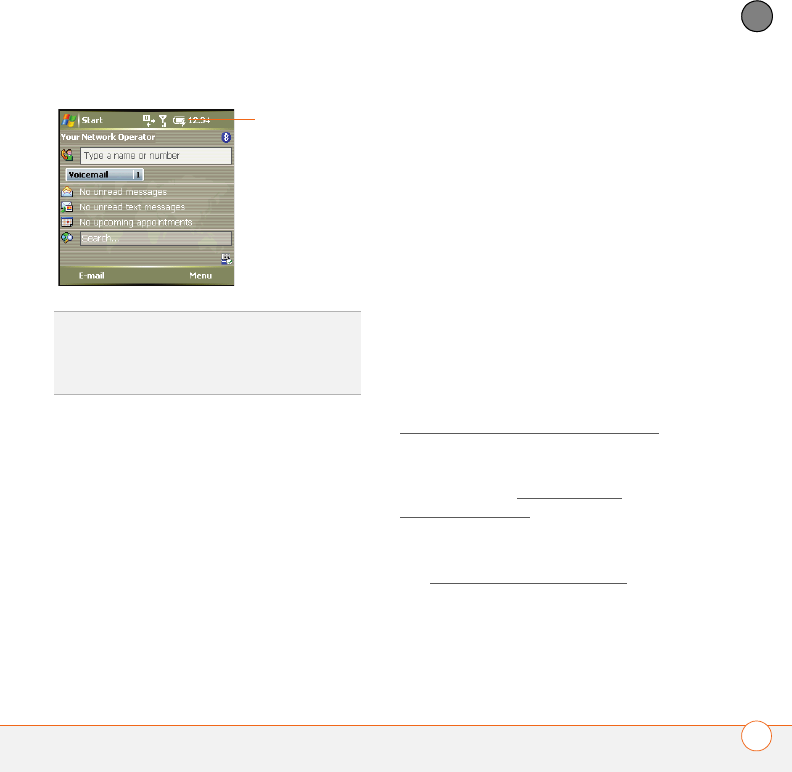
SETTING UP
CHARGING THE BATTERY 11
1
CHAPTER
Maximizing battery life
Battery life depends on how you use your
smartphone. You can maximize the life of
your battery by following a few easy
guidelines:
•Charge your smartphone whenever
you’re at your desk, or charge
it overnight each day. The battery in your
smartphone has a much longer useful
life if you charge it frequently instead of
waiting until it’s fully drained.
•If you spend a lot of time using the
camera, games, media players
(including listening to music with
wireless headphones using your
smartphone’s built-in Bluetooth®
wireless technology), or other
applications, keep an eye on the battery
icon and charge when necessary.
•If you are synchronizing email and other
information directly with your corporate
Exchange Server using Microsoft
Exchange ActiveSync®, set the
synchronization interval to not more
often than every 15 minutes during peak
times and every hour (or turned off
completely) during non-peak times (see
Setting the synchronization schedule).
•Turn off the Bluetooth feature when you
do not need to make a Bluetooth
connection (see Entering basic
Bluetooth settings).
•Turn the voice command feature off if
you have turned it on (it’s off by default;
see Setting up voice commands).
DID
YOU
KNOW
?
If your battery ever becomes
fully drained, your info remains safely stored
on your smartphone. Recharge the battery to
access your info.
Battery
icon
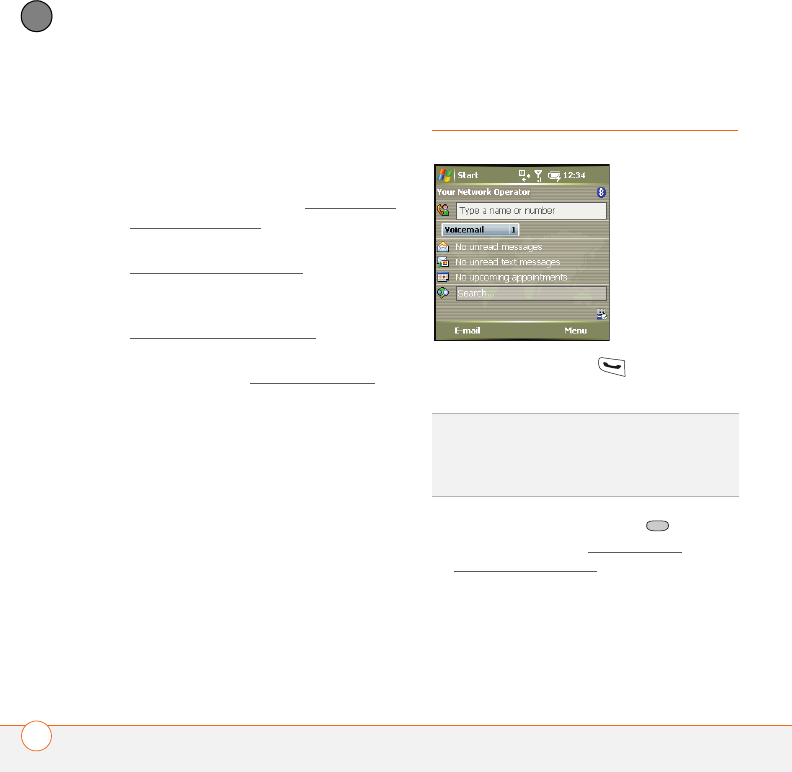
SETTING UP
MAKING YOUR FIRST CALL
12
1
CHAPTER
•As with any mobile phone, if you are in
an area with no wireless coverage, your
smartphone searches for a signal, which
consumes power. If you cannot move to
an area of better coverage, temporarily
turn off your phone (see Turning your
smartphone on/off).
•Turn down the screen brightness (see
Adjusting the brightness).
•Set your screen to turn off automatically
after a shorter period of inactivity (see
Optimizing power settings).
•Turn off the option to receive beamed
information (see Beaming a record).
•Keep your battery away from direct
sunlight and other sources of heat.
Temperatures over 50 degrees Celsius
(120 degrees Farenheit) can
permanently reduce the capacity and
life span of any lithium ion battery.
Making your first call
1Press Phone/Send to display your
Today screen.
2If prompted, press Center to turn
off Keyguard (see Locking your
keyboard (Keyguard) for more info).
3Use the number pad on the keyboard to
enter the number you want to call.
TIP
You can also press Power/End to display
your Today screen, unless you are on a call. If
you’re on a call, pressing Power/End hangs up
the call.
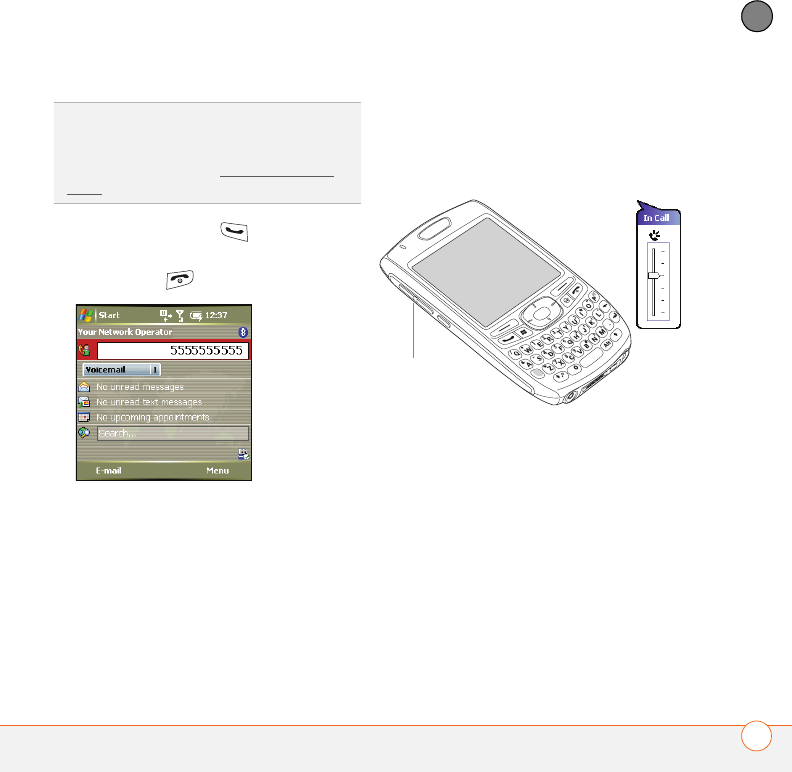
SETTING UP
MAKING YOUR FIRST CALL 13
1
CHAPTER
4Press Phone/Send to dial.
5When your call is complete, press
Power/End to end the call.
Adjusting call volume
While a call is in progress, press the
Vol ume button on the side of your
smartphone to adjust the call volume.
What’s my number?
Depending on your network operator, you
may be able to locate your smartphone’s
phone number using the Phone Settings
screen.
TIP
The Dial Lookup list might appear while
you are dialing a number. Continue entering
numbers to place the call. For more info on
the Dial Lookup list, see Dialing by contact
name.
Volume
button
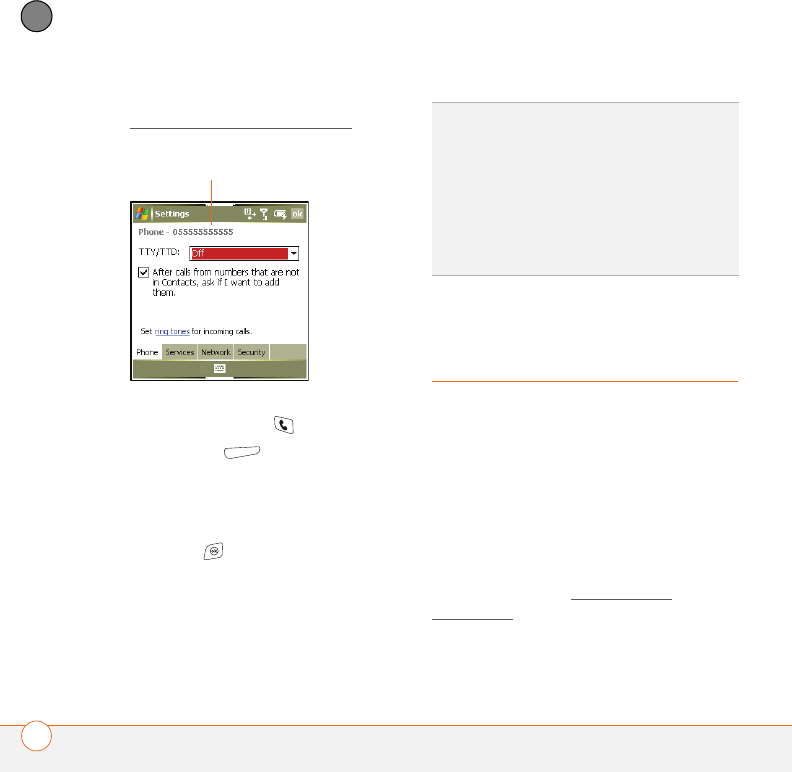
SETTING UP
SETTING UP SYNCHRONIZATION
14
1
CHAPTER
1Make sure your phone is on (see
Turning your smartphone on/off).
2If you do not see your Today screen,
press Phone/Send .
3Press Menu (right action key).
4Select Preferences > Phone Settings.
5On the Phone tab, look for your phone
number below the title bar.
6Press OK .
Setting up
synchronization
Once you’ve finished setting up your
smartphone, we recommend that you set
up a synchronization method to get the
most out of your smartphone.
Synchronization allows you to enter or
change information on your smartphone or
in Microsoft Office Outlook® on your
computer; your info is then automatically
updated in both places—no need to enter
the info twice. See Synchronizing
information.
Look here for your
phone number
TIP
If your phone number doesn’t appear on
the Phone Settings screen, your network has
not yet sent the number to the SIM card (this
does not affect SIM card functionality). Turn
your phone off, wait a few hours, and then
turn on your phone and repeat these steps. If
your phone number still does not appear,
please contact your network operator for
assistance.

CHAPTER
2
Moving around on your
smartphone
Have you ever been to a new city and felt a bit lost until you
figured out the streets? Learning to move around on your
smartphone is similar. Most applications that work on your
smartphone use the same set of controls. So once you learn
how to use these controls, you’ll be driving all over town and
you won’t even need a map.
Benefits
•Quickly move around and
complete tasks in applications
using one thumb on the 5-way
navigator
•Access extra features with menus
•Find and open applications quickly

In this chapter
Navigating around the screen . . . . . . . . . . . . . . . . . . . . . . . . . . . . . 17
Using the keyboard . . . . . . . . . . . . . . . . . . . . . . . . . . . . . . . . . . . . . 24
Opening and closing applications. . . . . . . . . . . . . . . . . . . . . . . . . . . 28
Using your Today screen . . . . . . . . . . . . . . . . . . . . . . . . . . . . . . . . . 29
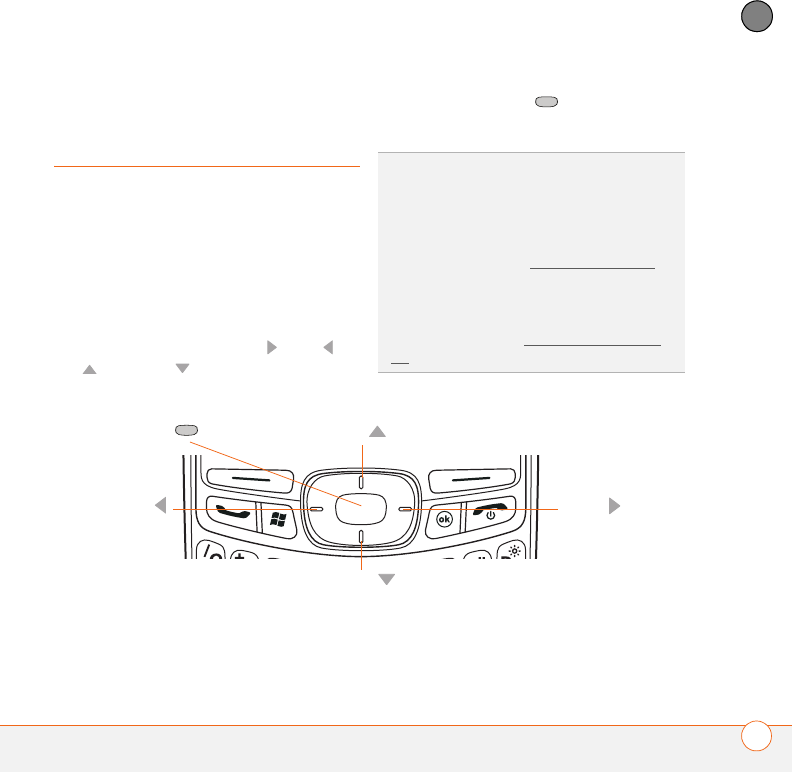
MOVING AROUND ON YOUR SMARTPHONE
NAVIGATING AROUND THE SCREEN 17
2
CHAPTER
Navigating around
the screen
To navigate around the Palm® Treo™ 750v
smartphone screen, you can use the 5-way
navigator or you can tap items on the
screen with the stylus. As you become
familiar with your smartphone, you’ll find
your own favorite way to scroll, highlight,
and select items.
Using the 5-way, press Right , Left ,
Up , or Down to move around the
screen. Press Center to highlight and
select items.
TIP
Some third-party applications may not
work with the 5-way navigator, and you must
use the stylus instead.
DID
YOU
KNOW
?
Custom navigation features
are available when you browse the web using
Internet Explorer. See Viewing a web page.
TIP
The arrow icons that indicate directions on
the 5-way are different from the onscreen
scroll arrows and the arrows that indicate that
a list is available (see Selecting options in a
list).
Up
Down
Left Right
Center
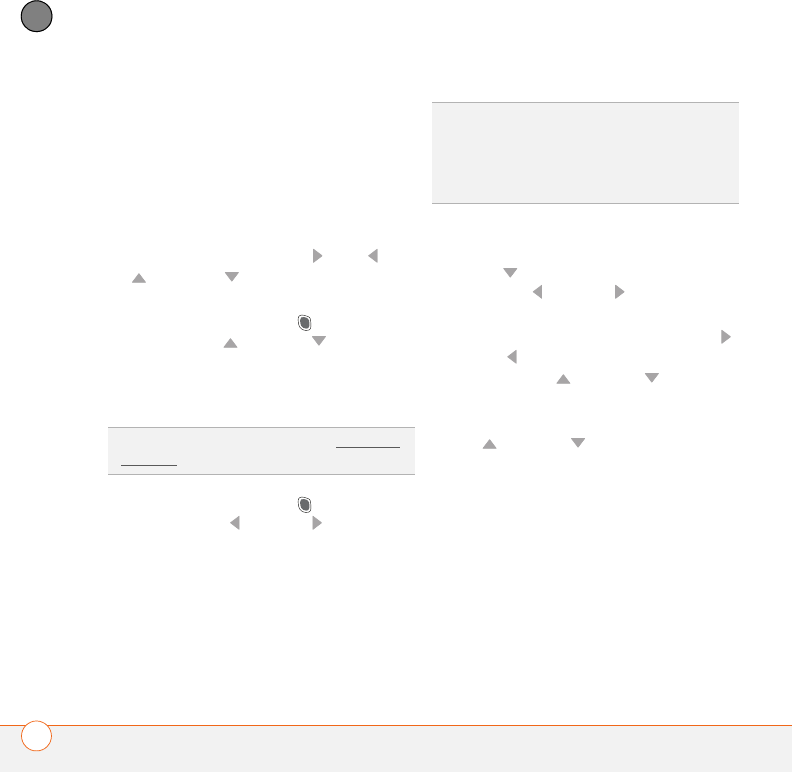
MOVING AROUND ON YOUR SMARTPHONE
NAVIGATING AROUND THE SCREEN
18
2
CHAPTER
Scrolling through screens
As on a computer, on your smartphone you
scroll to move from field to field or page to
page, or in some cases to highlight an item
or option in a list. There are several
methods of scrolling:
•Press the 5-way on the front of your
smartphone. Press Right , Left , Up
, or Down to move to the next
field, button, or action in that direction.
•Press and hold Option while
pressing Up or Down to scroll
one screen at a time. These keys work
just like the Page Up and Page Down
keys on your computer keyboard.
•Press and hold Option while
pressing Left or Right to jump to
the top or bottom of the current
document or entry.
•When viewing a screen with tabs, such
as when adding a contact, press
Down to scroll to the tabs, and then
press Left or Right to move
between tabs.
•When inside a text field, press Right
or Left to move to the next character,
and press Up or Down to move
between lines.
•When inside a list, press and hold
Up or Down to rapidly scroll
through the list.
•Tap an onscreen scroll arrow.
TIP
Can’t find the Option key? See Using the
keyboard.
TIP
When you are using applications such as
Inbox, Internet Explorer Mobile, and Word
Mobile, press and hold Option while pressing
Left or Right on the 5-way to automatically go
to the top and bottom of a screen.
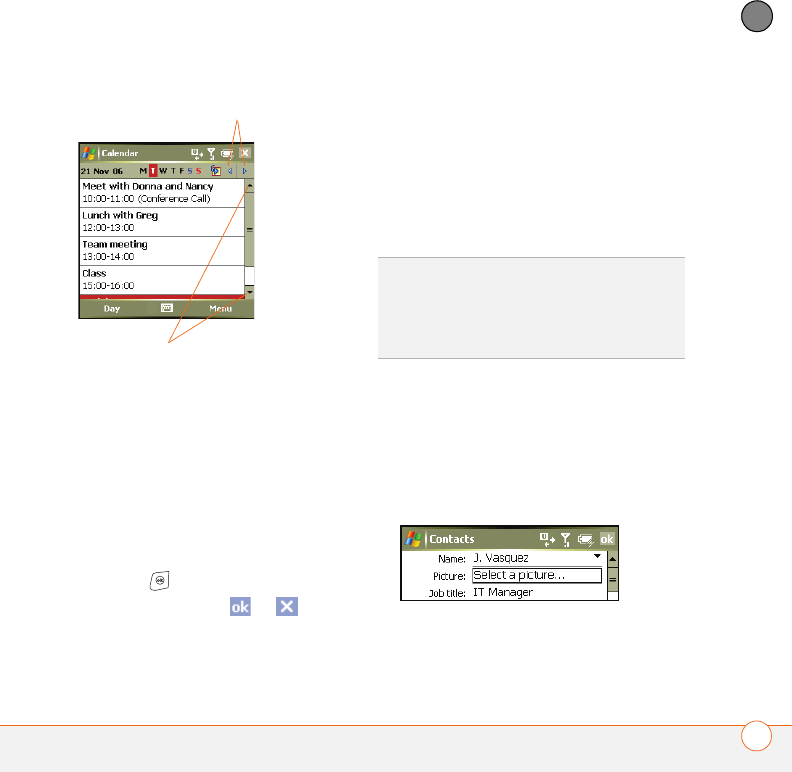
MOVING AROUND ON YOUR SMARTPHONE
NAVIGATING AROUND THE SCREEN 19
2
CHAPTER
•Tap and drag the slider of an onscreen
scroll bar.
Closing screens
To accept the information you entered on a
screen and to return to the previous
screen—or to return to the previous screen
without making any changes—do one of
the following:
•Press OK .
•Use the stylus to tap or in the
upper-right corner of the screen. These
buttons are not accessible using the
5-way.
Highlighting and selecting items
On most screens, one item—a button, a
list entry, or a check box—is highlighted by
default. The highlight identifies which item
is affected by your next action. Use the
5-way to move the highlight from one item
to another before opening or selecting it.
The highlight can take one of two forms,
depending on what is highlighted:
•Border: This rectangular border
highlights items such as an onscreen
button (such as OK, Dismiss, or Hide), a
check box, an option, or a web link.
Scroll arrows
Scroll arrows
TIP
The best way to learn to use the 5-way is
to experiment. Press the 5-way buttons and as
you do, follow the movement of the border
around the screen. The behavior of the 5-way
varies slightly in each application.
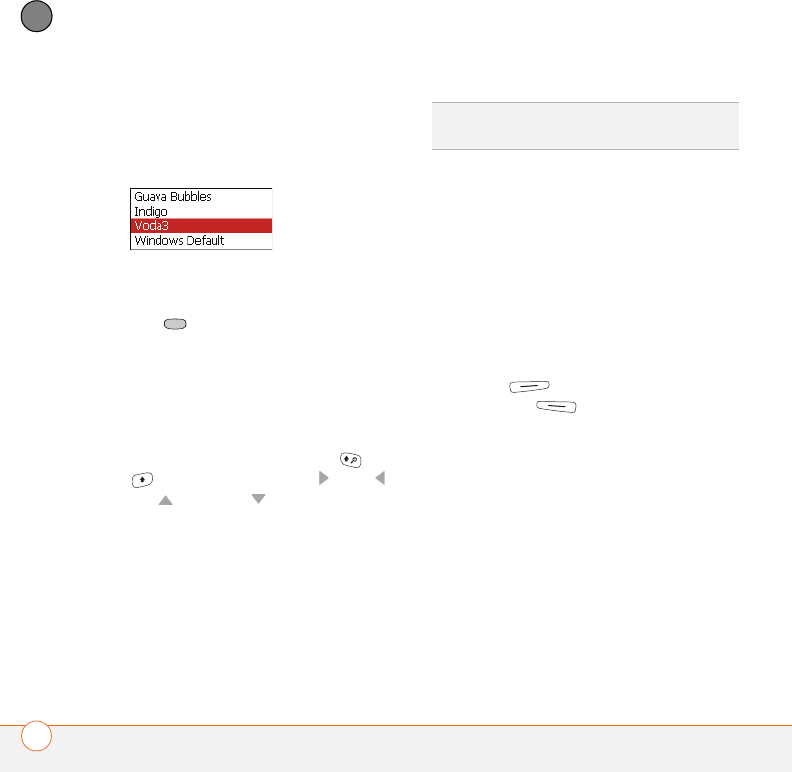
MOVING AROUND ON YOUR SMARTPHONE
NAVIGATING AROUND THE SCREEN
20
2
CHAPTER
•Reverse type (light text on a dark
background): This highlights items
such as a phone number, an email
address, text, or an item in a list.
After highlighting an item with the 5-way,
you can select or activate it by pressing
Center or by tapping the item with the
stylus.
Highlighting text
You can use the 5-way or the stylus to
highlight text on the screen:
•5-way: Press and hold Shift ( or
) while pressing Right , Left ,
Up , or Down to extend the
highlight in that direction.
•Stylus: Tap and drag the stylus across
the text you want to highlight. To
highlight a word, double-tap it. To
highlight a paragraph, triple-tap it.
Using the action keys
The left and right action keys give you quick
access to tasks that you can do on the
current screen, so the action key items
vary from application to application and
from screen to screen. Look on the screen
directly above the action key to see the
action that it takes in the current context.
In some contexts, these keys may do
nothing at all. In most cases the right
action key opens the menu, and the
left action key activates a specific
command, such as New or Edit.
Remember that action key functions vary
from screen to screen, so be sure to check
the onscreen label before pressing the
action keys.
TIP
When text is highlighted, you can press
Backspace to delete the highlighted text.
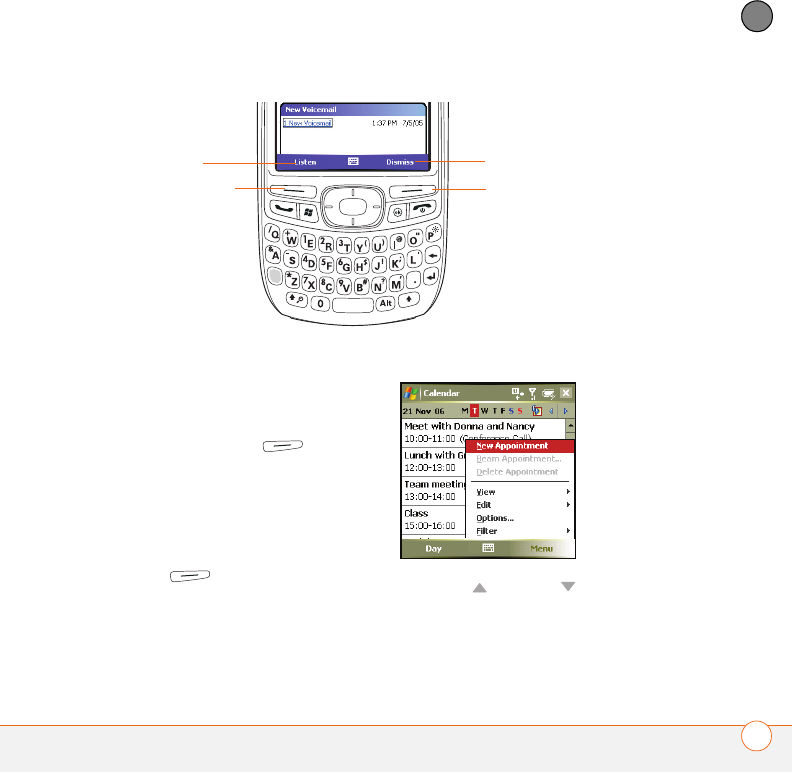
MOVING AROUND ON YOUR SMARTPHONE
NAVIGATING AROUND THE SCREEN 21
2
CHAPTER
Selecting menu items
In many applications, a menu provides
access to additional features. The menu is
hidden until you press Menu (right
action key). To get the most out of your
smartphone, it’s a good idea to familiarize
yourself with the additional features
available through the menu in various
applications.
1Press Menu (right action key) to
display an application’s menu. 2Press Up or Down to highlight a
menu item.
Left action key Right action key
Left action key
activates this
command
Right action key
activates this
command
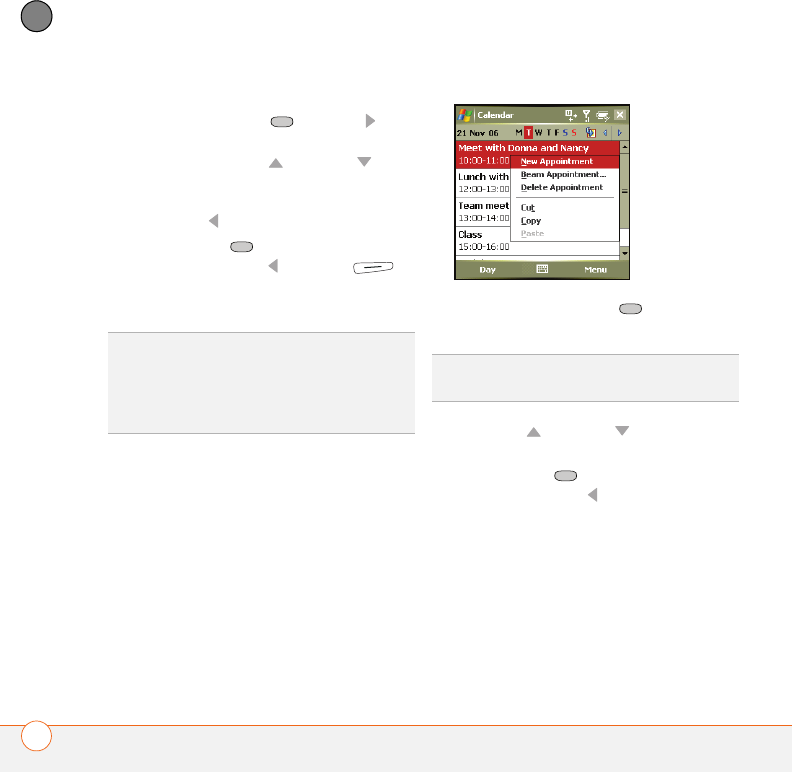
MOVING AROUND ON YOUR SMARTPHONE
NAVIGATING AROUND THE SCREEN
22
2
CHAPTER
3If an arrow appears next to a menu
item, press Center or Right to
display additional options for that item,
and then press Up or Down to
highlight a menu item. To return to the
main menu without making a selection,
press Left .
4Press Center to select the menu
item, or press Left or Menu
(right action key) to close the menu and
cancel your selection.
Selecting options in a shortcut menu
Most applications also provide access to
context-sensitive, shortcut menus—similar
to the right-click menus on a computer. The
shortcut menu options vary based on the
highlighted selection.
1Highlight the item whose shortcut
menu you want to see.
2Press and hold Center to open the
shortcut menu.
3Press Up or Down to highlight a
menu item.
4Press Center to select the menu
item or press Left to cancel your
selection.
Selecting options in a list
Lists enable you to select from a range of
options. You can identify whether a list is
available when you select the field. If a
rectangle appears around the field along
with a downward-pointing arrow, a list is
DID
YOU
KNOW
?
You can select most menu
items by pressing a key on the keyboard. To
quickly access a menu item, press Menu
(right action key) followed by the underlined
letter in the menu item’s name.
TIP
You can also tap and hold the stylus on an
item to open the shortcut menu.
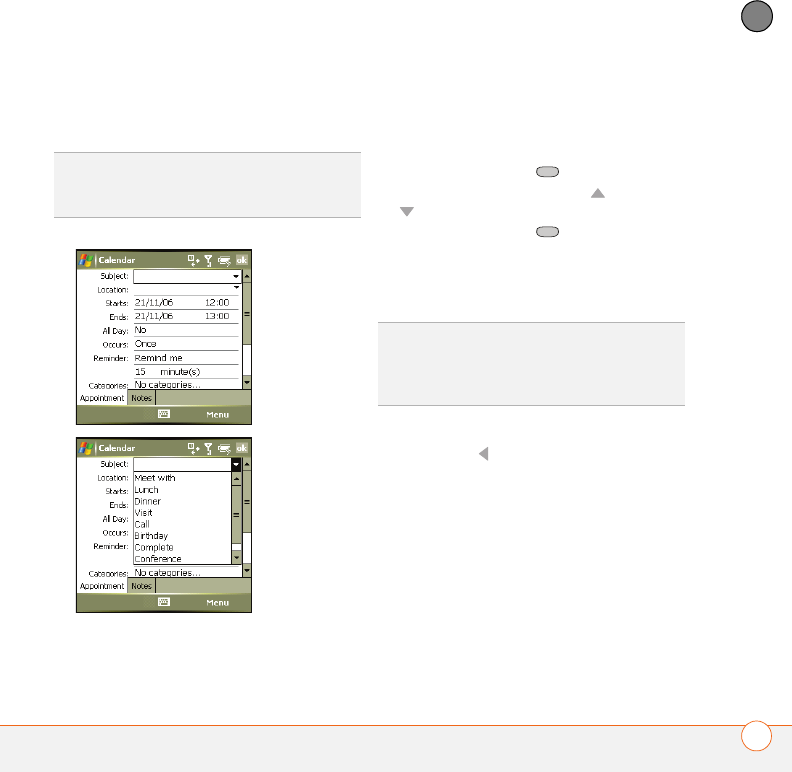
MOVING AROUND ON YOUR SMARTPHONE
NAVIGATING AROUND THE SCREEN 23
2
CHAPTER
available. Lists are different from the
menus described earlier in this section.
To select from a list, do any of the
following:
•Use the 5-way to highlight the field, and
then press Center to display the
items in the list. Press Up or Down
to highlight the item you want, and
then press Center to make your
selection.
•Use your stylus to tap the arrow, and
then tap the item in the list.
•To exit the list and cancel your selection,
press Left .
TIP
When selecting fields you might not see
the downward-pointing arrow until you press
Center on the 5-way.
DID
YOU
KNOW
?
In fields where you see a
downward-pointing arrow but no rectangle,
you must tap the arrow with the stylus to
expand the field.
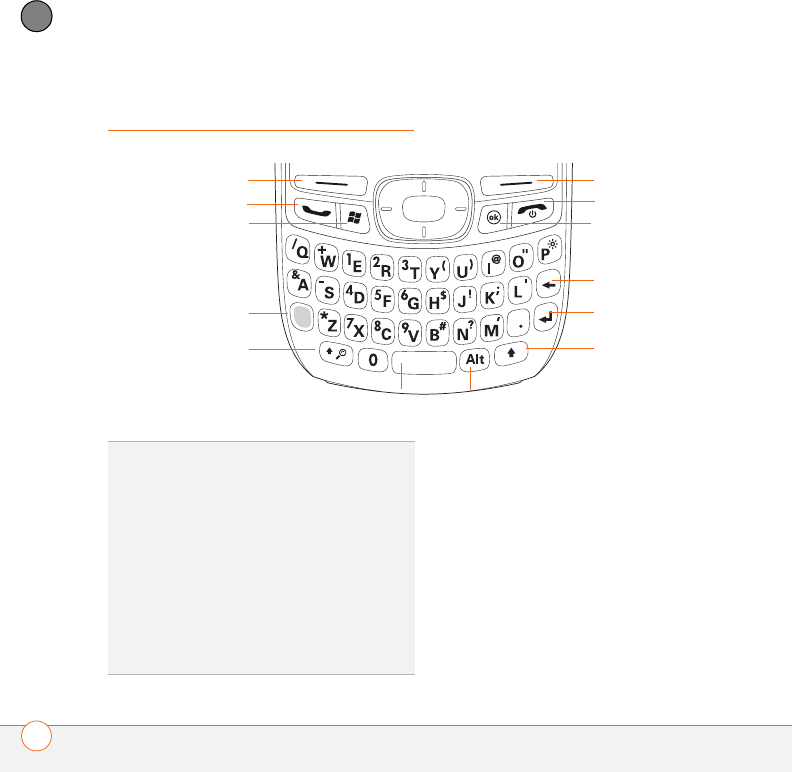
MOVING AROUND ON YOUR SMARTPHONE
USING THE KEYBOARD
24
2
CHAPTER
Using the keyboard
Understanding the keyboard backlight
Your smartphone includes a keyboard
backlight for low light conditions. The
keyboard backlight activates automatically
when the screen turns on. The backlight
turns off automatically when the screen
turns off or when you are on a call or
playing music in the background for longer
than the time specified in Backlight
Settings. You can set different time
intervals depending on whether the
smartphone is operating on battery power
Left
action key Right
action key
Phone/Send
Start
Power/End
OK
Backspace
Option
Shift/Search
Space
Return
Shift
Alt
TIP
When using the keyboard, most people
find it easiest to hold the smartphone with
two hands, using the tips of both thumbs to
press the keys.
DID
YOU
KNOW
?
You can also use the onscreen
keyboard to enter letters, numbers, and other
characters in applications that support this
feature. Tap the keyboard icon in the center at
the bottom of any screen where it appears.
After opening the keyboard, you can set
various input options by tapping the arrow to
the right of the keyboard icon.
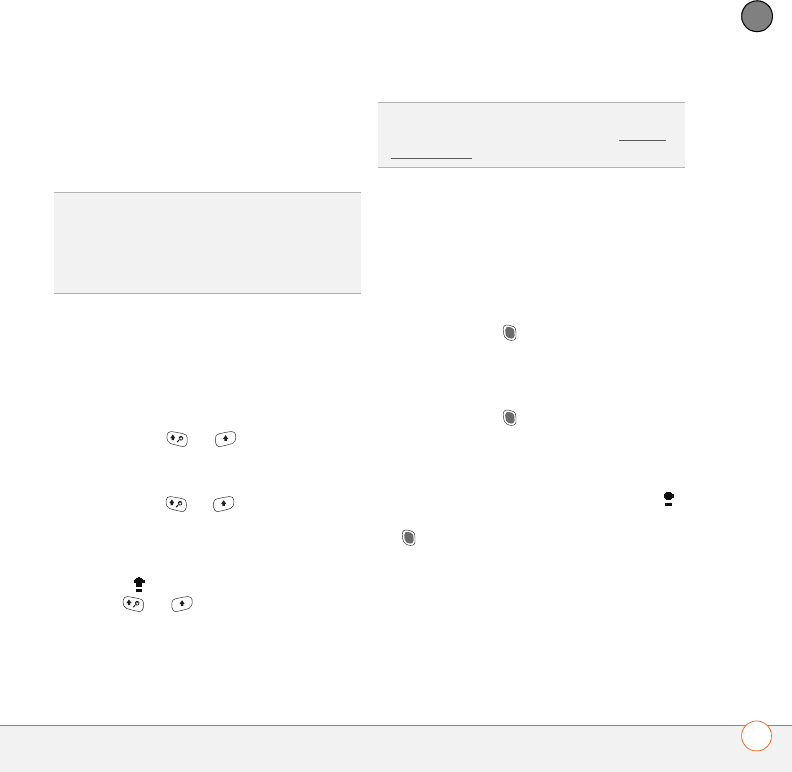
MOVING AROUND ON YOUR SMARTPHONE
USING THE KEYBOARD 25
2
CHAPTER
or is connected to an external power
source. The backlight also turns off when
an application’s power-saving features turn
it off.
Entering lowercase and uppercase letters
By default, the first letter of each sentence
or field is capitalized and the remaining text
you enter is lowercase. To enter other
uppercase letters, do one of the following:
•Press Shift ( or ), and then enter
a letter. You don’t need to press and
hold Shift while entering a letter.
•Press Shift ( or ) twice to turn on
Caps Lock, and then enter a series of
letters. When Caps Lock is on, this
symbol appears at the bottom of the
screen: . To turn off Caps Lock, press
Shift ( or ) again.
Entering numbers, punctuation, and
symbols
Numbers, punctuation, and symbols
appear above the letters on the keys. To
enter these characters, do one of the
following:
•Press Option , and then press the
key of the desired character. You don’t
need to hold Option while pressing the
key.
•Press Option twice to turn on
Option Lock, and then press the desired
keys to enter a series of characters.
When Option Lock is on, this symbol
appears at the bottom of the screen: .
To turn off Option Lock, press Option
again.
TIP
You can change the backlight shut-off
interval. Press Start and select Settings.
Select the System tab, and then select
Backlight. Set the time interval on the Battery
Power tab and on the External Power tab.
TIP
You can turn off the first-letter
capitalization setting. For details see Setting
input options.

MOVING AROUND ON YOUR SMARTPHONE
USING THE KEYBOARD
26
2
CHAPTER
Entering other symbols and accented
characters
You can enter symbols and accented
characters that don't appear on the keys by
using the alternate characters list.
1Press Alt to display the alternate
character list.
2Narrow the list by pressing the key that
corresponds to the character you want.
For example, to enter an é, press e. See
the following table for a list of
corresponding characters.
3Press Up or Down to highlight the
desired character.
4Press Center to insert the
character.
TIP
The alternate characters are grouped
according to their similarity to the
corresponding key. For example, alternate
characters available for the e key include é and
è, and the alternate character for the N key is
Ñ. If you press the wrong key, press
Backspace to return to the full list of alternate
characters. You can then press another key.
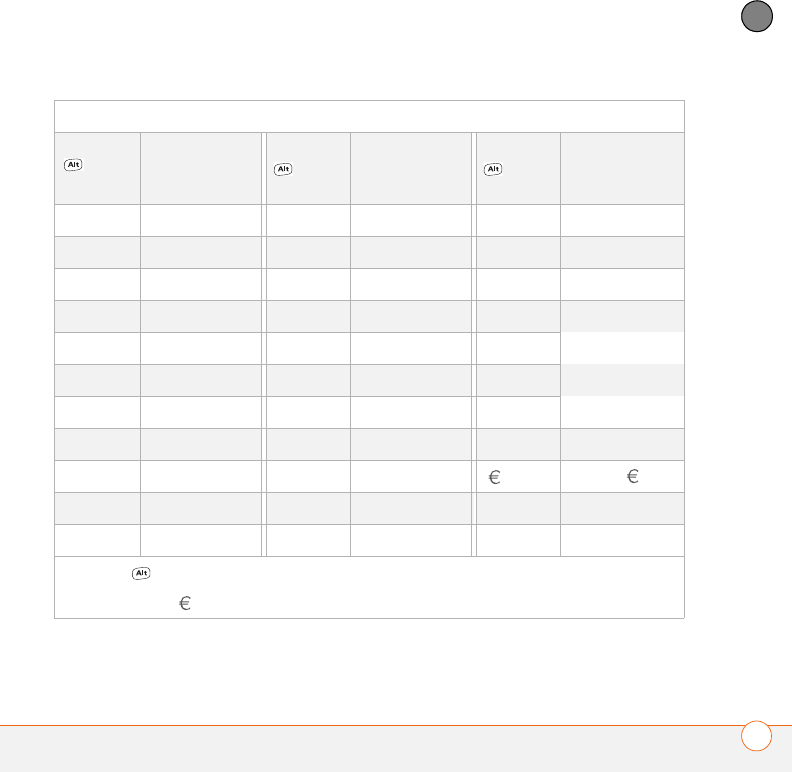
MOVING AROUND ON YOUR SMARTPHONE
USING THE KEYBOARD 27
2
CHAPTER
0
Symbols and accented characters
Press Alt
and
enter…
to select… Press Alt
and
enter…
to select… Press Alt
and
enter…
to select…
a á à ä â ã å æ n ñ x or X x ¤
AÁ À Ä Â Ã Å Æ N Ñ y ý ÿ
b or B ß o ó ò ö ô œ õ Y Ý Ÿ
cç ¢ © OÓ Ò Ö Ô Œ Õ 0°
C Ç ¢ © p or P ¶ 1 1¼½
eé è ë ê r or R ® 2 2
E É È Ë Ê s ß š 3
3
¾
f or F ƒ S ß Š ! ¡
i í ì ï î t or T ™ $ £ ¥ ¢
IÍ Ì Ï Î uú ù ü û
l or L £ U Ú Ù Ü Û
Press Alt by itself to select these characters:
: & _ • % = ÷ ^ £ ¥ ¢ $ [ ] { } < > « » © ® ° ~ \ Ø µ |
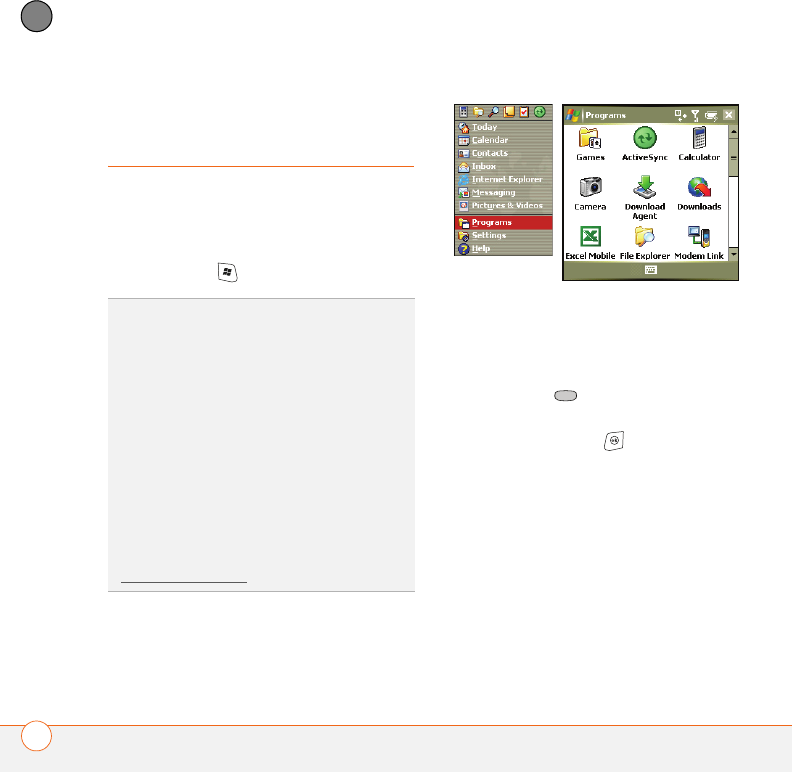
MOVING AROUND ON YOUR SMARTPHONE
OPENING AND CLOSING APPLICATIONS
28
2
CHAPTER
Opening and closing
applications
Opening applications
You can access all the applications on your
smartphone through the Start menu.
1Press Start to open the Start menu.
2Use the 5-way navigator to highlight the
application you want to use. To view
additional applications, select
Programs.
3Press Center to open the
highlighted application.
4(Optional) Press OK to return to
Programs and open another application.
The current application continues to run
in the background.
Closing applications
You can have several applications open at
once, so you don’t need to exit an
application to open another one. In most
cases, applications close automatically
when available memory is low, but you can
also close applications manually.
TIP
With the Start menu open, press the letter
underlined in the application’s name to open
the app. For example, press H to open Help.
Or, select the shortcut icons at the top of the
Start menu to open recently used
applications.
In Programs, press a letter to jump to the first
app that begins with that letter. For example,
press C to jump to Calculator. Press C again to
jump to Camera, and so on.
DID
YOU
KNOW
?
You can open apps by pressing
and holding Option and then pressing Phone/
Send, Start, or OK. You can change which
app a button combination opens; see
Reassigning buttons for details.

MOVING AROUND ON YOUR SMARTPHONE
USING YOUR TODAY SCREEN 29
2
CHAPTER
NOTE If you press OK to leave an
application, the current application
continues to run in the background.
Manually closing applications helps
conserve battery power and frees up
memory.
1Press and hold OK to open Memory
Settings.
2On the Running Programs tab, do one
of the following:
•Select the application you want to
close, and then select Stop to close
it.
•Select Stop All to close all your open
applications.
Using your Today
screen
Your Today screen is your home base. From
your Today screen you can quickly look up a
contact, make a call, see your latest
calendar appointments, see the number of
unread email messages, and even perform
a web search.
To access your Today screen, press
Phone/Send .
TIP
If you press Phone/Send while a number
is highlighted, your smartphone dials the
number. If a number is highlighted and you
want to access the Today screen, press OK to
clear the dial window, or use the Start menu.
TIP
You can also open the Today screen by
pressing Power/End, unless you are on a call.
If you’re on a call, pressing Power/End hangs
up the call. If the Today screen is already
displayed and you’re not on a call, pressing
Power/End turns off the screen display.
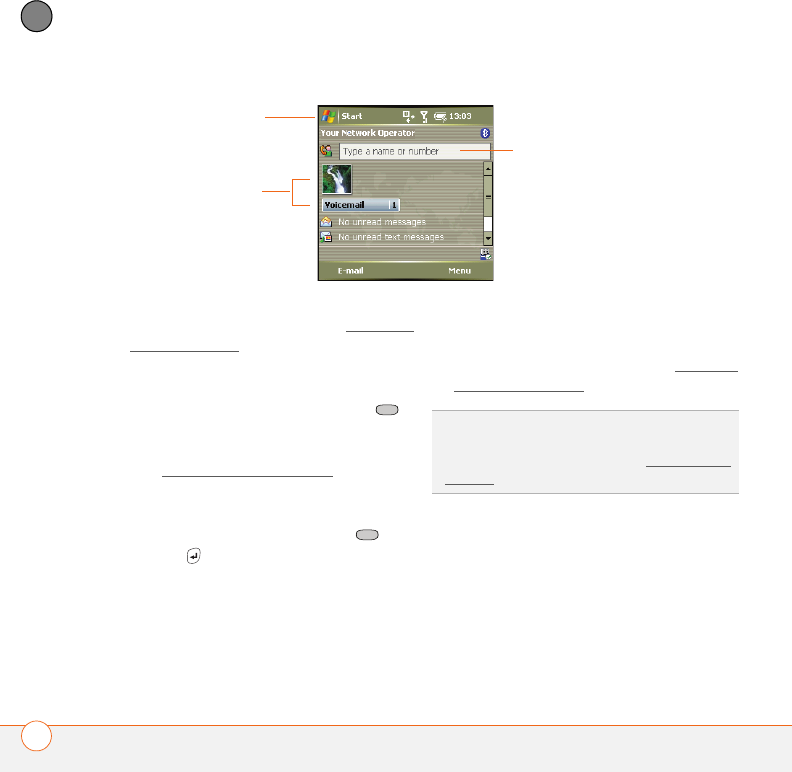
MOVING AROUND ON YOUR SMARTPHONE
USING YOUR TODAY SCREEN
30
2
CHAPTER
•Title bar and status info: See What are
all those icons? to learn about the icons
that appear in this area.
•Dial Lookup field: Type the number
you want to call and press Center
to dial, or begin typing a name to look
up the associated number in Contacts.
See Dialing by contact name for more
info.
•Web search field: Enter a web address
or a keyword and press Center or
Return to view a list of search
results based on the address or word
(data services connection required).
•Speed-dial entries: Select a speed-dial
button—either a picture or text—to call
the number assigned to it. See Defining
speed-dial buttons to create your own.
Title bar and
status info
Dial Lookup field
Speed-dial
entries
Scroll down to display Web
search field
TIP
You can select a picture for your Today
screen background and select which items
appear in the Today screen. See Today screen
settings for details.

CHAPTER
3
Your phone
The phone, along with the Today screen, is your home base for
making and receiving calls.
You can creatively manage multiple calls; for example, you can
swap between calls, send text messages to ignored calls, and
create conference calls.
And you can do more than manage your phone calls. You can
send text messages, open applications, go to your favorite web
pages, see your upcoming appointments, and even find out
how many unread email messages you have.
Benefits
•Stay in touch—you choose how
•Work in other applications when
on an active call.
•Create speed-dial buttons with
pictures of your friends

In this chapter
Turning your smartphone on/off . . . . . . . . . . . . . . . . . . . . . . . . . . . . 33
Making calls from the Today screen. . . . . . . . . . . . . . . . . . . . . . . . . 34
Other ways of making calls . . . . . . . . . . . . . . . . . . . . . . . . . . . . . . . 38
Receiving calls . . . . . . . . . . . . . . . . . . . . . . . . . . . . . . . . . . . . . . . . . 39
Using voicemail . . . . . . . . . . . . . . . . . . . . . . . . . . . . . . . . . . . . . . . . 40
What can I do during a call? . . . . . . . . . . . . . . . . . . . . . . . . . . . . . . . 41
How many minutes have I used?. . . . . . . . . . . . . . . . . . . . . . . . . . . 47
Defining speed-dial buttons . . . . . . . . . . . . . . . . . . . . . . . . . . . . . . . 47
Using a phone headset . . . . . . . . . . . . . . . . . . . . . . . . . . . . . . . . . . 50
Customizing phone settings. . . . . . . . . . . . . . . . . . . . . . . . . . . . . . . 54
What are all those icons?. . . . . . . . . . . . . . . . . . . . . . . . . . . . . . . . . 62

YOUR PHONE
TURNING YOUR SMARTPHONE ON/OFF 33
3
CHAPTER
Turning your
smartphone on/off
The term smartphone refers to the device
and its physical aspects. The term phone
refers to the wireless feature of your
smartphone that enables you to connect to
your network operator’s network so that
you can make and receive calls, and send
and receive data.
The phone and the screen of your
smartphone can be turned off and on
separately. This means you can wake up
the screen to use just the organizer
features of your device without turning on
the phone. Also, when the screen is turned
off the phone can be on and ready for you
to receive phone calls or messages.
Turning your phone on
From the Today screen, press Menu
(right action key), select Wireless
Manager, and then select Phone. When
your smartphone locates a signal, your
network operator’s name appears in the
upper-left of the screen and the
signal-strength icon appears at the top
of the screen.
When you turn on your phone, it connects
to a mobile network so that you can make
and receive phone calls and use other
wireless services (if supported by the local
network). When you are inside a coverage
area, the signal-strength icon has bars
in it. If you’re outside a coverage area, the
indicator light flashes amber and no bars
appear in the signal-strength icon.
Turning your phone off
From the Today screen, press Menu
(right action key)), select Wireless
Manager, and then select Phone. When
your phone is off, the phone-off icon
appears at the top of the screen and Phone
Off appears in the upper-left of the screen.
Your phone is not connected to any mobile
network. Although you can no longer use
DID
YOU
KNOW
?
You can press and hold the
Power/End button to turn your phone on and
off.
DID
YOU
KNOW
?
You can go to Wireless
Manager by tapping the signal-strength icon
and tapping Wireless Manager.
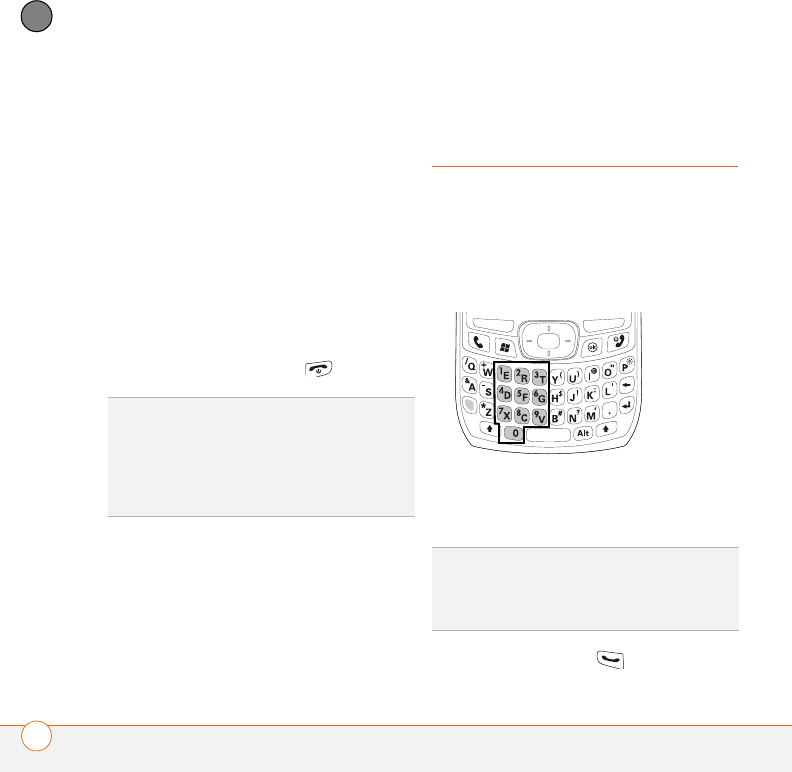
YOUR PHONE
MAKING CALLS FROM THE TODAY SCREEN
34
3
CHAPTER
the phone, you can still use Microsoft
Office applications and all the organizer
features of your smartphone.
Waking up the screen and turning it off
Wake up the screen and leave the phone
turned off when you want to use only the
organizer features of your smartphone, for
example, when you’re on a plane and want
to look at your calendar. You can also turn
off your smartphone’s screen without
turning off your smartphone’s wireless
features. You can turn your screen on and
off by pressing Power/End .
Making calls from the
Today screen
Your smartphone offers several ways to
make phone calls from the Today screen.
Dialing from the Today screen
1Go to your Today screen.
2Using the numbered keys on the
keyboard, enter a phone number in the
Dial Lookup field.
3Press Phone/Send to dial.
TIP
You can set how long the screen stays on.
Press Start, select Settings, select the
System tab, and then select Power. Select
the Advanced tab. Adjust the number of
minutes the phone stays on when idle using
the On battery power setting.
DID
YOU
KNOW
?
When you're dialing a phone
number, you can enter * and # without first
pressing Option. This makes it easy to
respond to further dialing instructions.

YOUR PHONE
MAKING CALLS FROM THE TODAY SCREEN 35
3
CHAPTER
NOTE You do not need to press Option to
access the numbers on the keyboard.
However, when dialing short numbers the
number may conflict with a contact name.
If this occurs, press Option to avoid
starting a contact lookup. For emergencies,
you can always dial 112 without pressing
Option first.
Dialing with a speed-dial button
Your smartphone enables you to create
both picture and text speed-dial buttons so
that you can select a button on the Today
screen to quickly dial a number.
BEFORE YOU BEGIN Create some
speed-dial buttons. See Defining speed-dial
buttons. You can customize the default
speed-dial buttons. See Editing a
speed-dial button.
You can make a call using your speed-dial
buttons by doing any of the following:
•Select a speed-dial button with the
5-way, and then press Center .
•Tap a speed-dial button with the stylus.
•Press and hold the Quick Key that you
assigned to the speed-dial button.
•To dial an alternate number for a
contact, highlight the speed-dial button
and press and hold Center , or tap
and hold the button, and then select a
number from the shortcut menu.
To see more speed-dial buttons, highlight
the picture speed-dial area and press Right
or Left repeatedly, or highlight the text
speed-dial area and press Up , Down ,
Right , or Left .
TIP
If you press Phone/Send while a number
is highlighted, your device dials the number. If
a number is highlighted and you want to
access the Today screen, press OK to clear
the dial window, or use the Start menu.
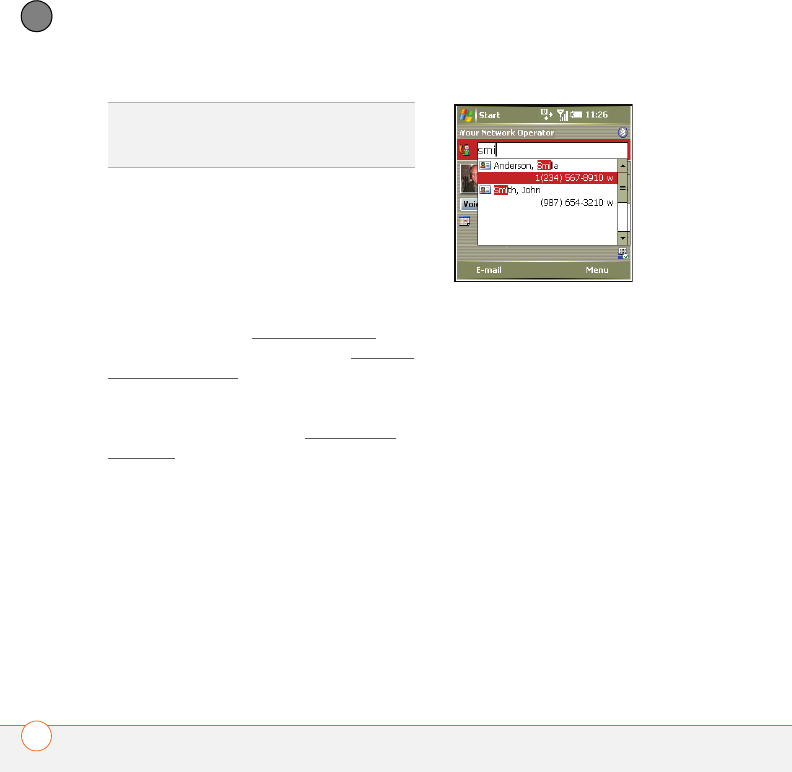
YOUR PHONE
MAKING CALLS FROM THE TODAY SCREEN
36
3
CHAPTER
Dialing by contact name
You can look up contacts quickly by
entering just a few letters of a contact’s
name directly from your Today screen.
BEFORE YOU BEGIN Before you can dial a
number by contact name, you must create
some contacts (see Adding a contact,) or
import them by synchronizing (see Defining
speed-dial buttons).
Make sure your phone is on and that you’re
inside a coverage area (see Turning your
phone on).
1Go to your Today screen.
2Using the keyboard, begin entering one
of the following for the contact you
want to call:
•First name (JOH for John)
•Last name (SMI for Smith)
•First initial, a space, and then last
initial (J S for John Smith)
•First name and last name
(JOH SMI for John Smith)
For example, entering SM finds both
Smilla Anderson and John Smith.
Entering SMA finds only Smilla
Anderson.
To clear the Dial Lookup field and start
another Contacts search, press OK. To
delete letters when correcting a
misspelled name, press Backspace.
TIP
You can hide your speed-dial buttons on
your Today Screen and still use your Quick
Keys to call a speed-dial number.
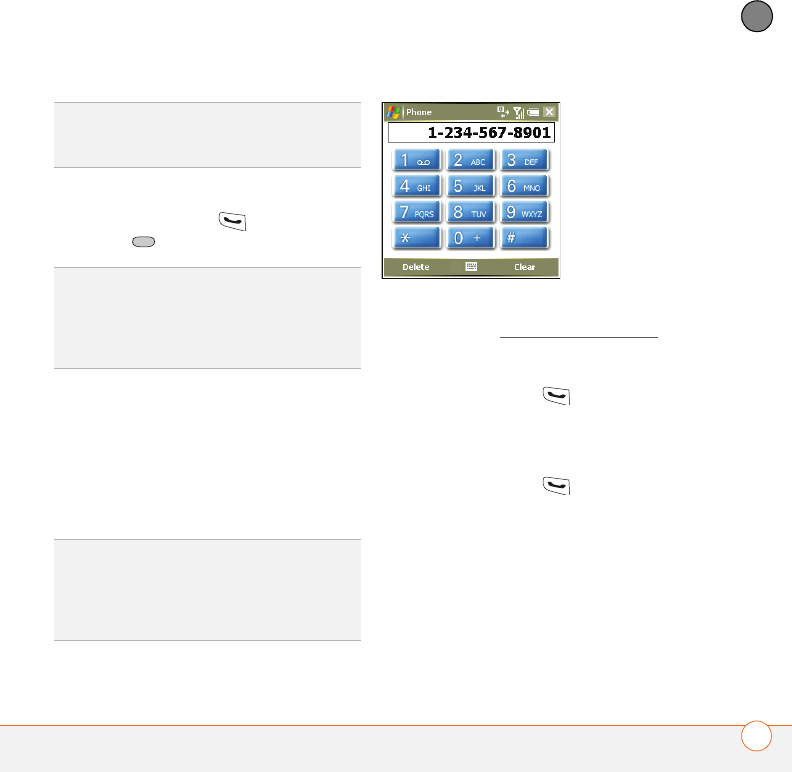
YOUR PHONE
MAKING CALLS FROM THE TODAY SCREEN 37
3
CHAPTER
3Select the number you want to dial.
4Press Phone/Send or press
Center to dial.
Dialing using the onscreen Dial Pad
The onscreen Dial Pad is useful when you
need to dial numbers that are expressed as
letters and when you need large numbers
that you can tap with your finger or the
stylus.
BEFORE YOU BEGIN Make sure your
phone is on (see Turning your phone on).
1Go to your Today screen.
2Press Phone/Send and select
Dial Pad.
3Tap the onscreen Dial Pad to enter the
number.
4Press Phone/Send to dial.
TIP
To see a contact’s address, company, and
other details, press Up to highlight the name
and press Center on the 5-way.
DID
YOU
KNOW
?
After you look up a contact,
you can select how you want to communicate
with that person. Press and hold Center on
the 5-way, or tap and hold, and then select the
communication method you want to use.
DID
YOU
KNOW
?
You can paste numbers
directly into the Dial Pad. Copy a number from
another application, switch to Dial Pad, and
then press and hold Center on the 5-way to
paste the number.
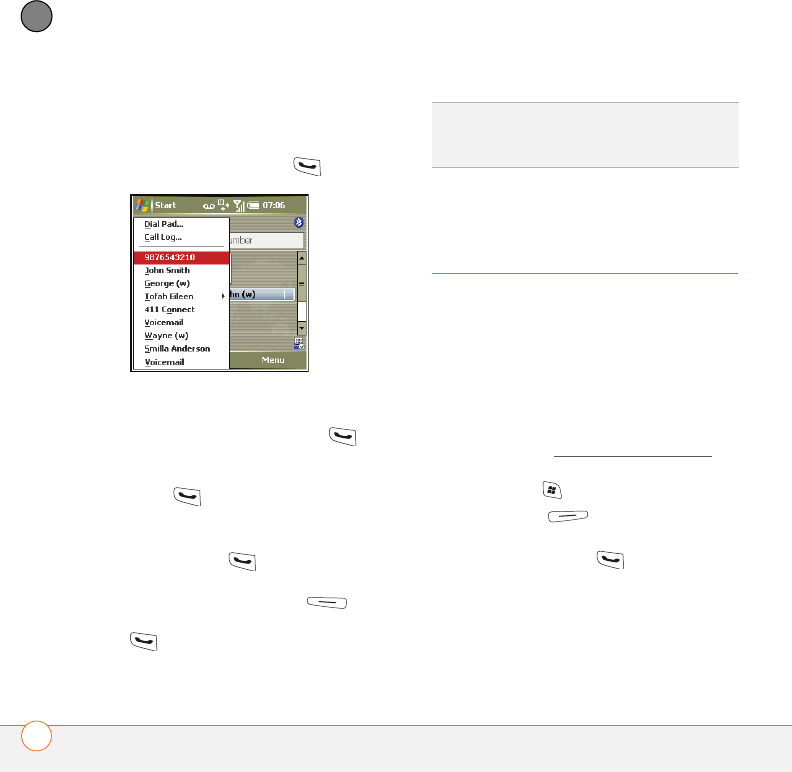
YOUR PHONE
OTHER WAYS OF MAKING CALLS
38
3
CHAPTER
Redialing a recently called number
•To dial the last number you called:
Go to your Today screen, and then press
and hold Phone/Send .
•To select from your most recently
dialed numbers: Go to your Today
screen, press Phone/Send ,
highlight the number or contact name
you want to call, and then press Phone/
Send to dial.
•To select from a chronological list of
calls: Go to your Today screen, press
Phone/Send , and then select Call
Log. Highlight the number you want to
call, and then press Call (left
action key) to dial or press Phone/Send
.
Other ways of
making calls
Your smartphone offers several other ways
to make phone calls than from the Today
screen. Try them all and you’ll discover
which methods you prefer.
Dialing by company name
BEFORE YOU BEGIN Make sure your
phone is on (see Turning your phone on).
1Press Start and select Contacts.
2Press Menu (right action key)
and select View By > Company.
3Press Phone/Send to go to your
Today screen.
4Using the keyboard, begin entering the
first few letters of the company name.
5Select the number you want to dial.
TIP
You can also access the Call Log and Dial
Pad from the Today screen by pressing Menu
(right action key).
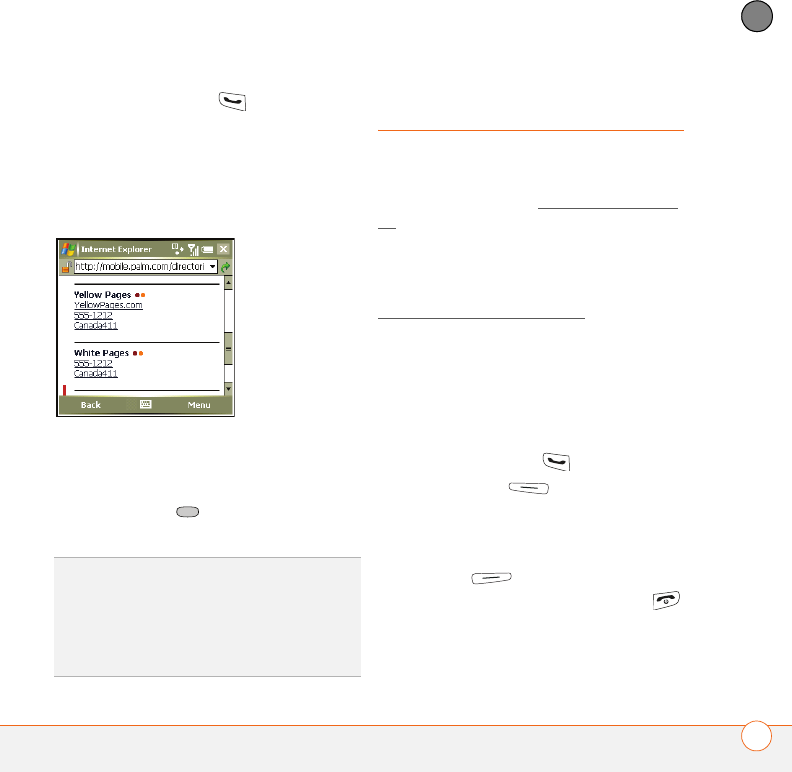
YOUR PHONE
RECEIVING CALLS 39
3
CHAPTER
6Press Phone/Send to dial.
Dialing from a web page or message
Your smartphone recognizes most phone
numbers that appear in web pages or in
messages (text, email, or multimedia).
1Use the 5-way to highlight the phone
number you want to dial in the web
page or message.
2Press Center to open the Phone
dialog box, and then select Ye s to dial.
Receiving calls
To receive calls, your phone must be on.
This is different from having only the
screen turned on (see Turning your phone
on). When your phone is off, your calls go
to voicemail.
To see a picture of the person calling you!
Learn how to assign a caller ID picture in
Assigning a caller ID ringtone.
If music is playing when a call arrives, the
smartphone rings softly. You can answer
the phone as you normally would. The
audio pauses during your call.
To answer a call, do one of the following:
•Press Phone/Send .
•Press Answer (left action key).
•If the headset is attached, press the
headset button.
To ignore a call and send it to voicemail,
press Menu (right action key) and
select Ignore or press the Power/End
key.
TIP
If you can’t dial a phone number directly
from a web page or a message, then highlight
the number, select Edit (right action key), and
select Copy. Open the Dial Pad, and then
press and hold Center on the 5-way to paste.
Press Phone/Send to dial.
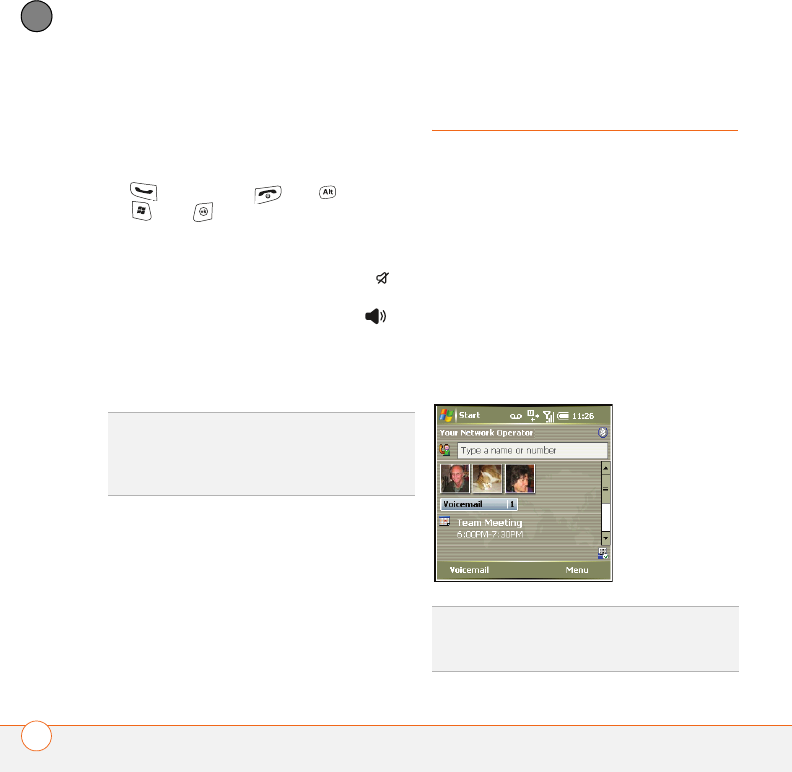
YOUR PHONE
USING VOICEMAIL
40
3
CHAPTER
To silence the ringer while your
smartphone is ringing:
•Press the Volume button or any key on
your smartphone except Phone/Send
, Power/End , Alt , Start
, OK , or the 5-way.
•To immediately silence all system
sounds including the ringer, slide the
ringer switch to Sound Mode Off .
All sounds remain off until you slide the
ringer switch back to Sound On .
When you silence the ringer, you can either
answer the call or let it ring through to
voicemail.
Using voicemail
Setting up voicemail.
1Go to your Today screen.
2Press and hold 1 on the keyboard or tap
the Voicemail speed-dial button to dial
your network operator’s voicemail
system.
3Follow the voice prompts to set up your
voicemail.
Retrieving voicemail messages from the
Today screen
DID
YOU
KNOW
?
You can also ignore a call and
send a text message. Press Menu (right
action key) and select Ignore with text
message.
DID
YOU
KNOW
?
When a Voicemail icon
appears at the top of the screen, you can tap
this icon to retrieve your voicemail.
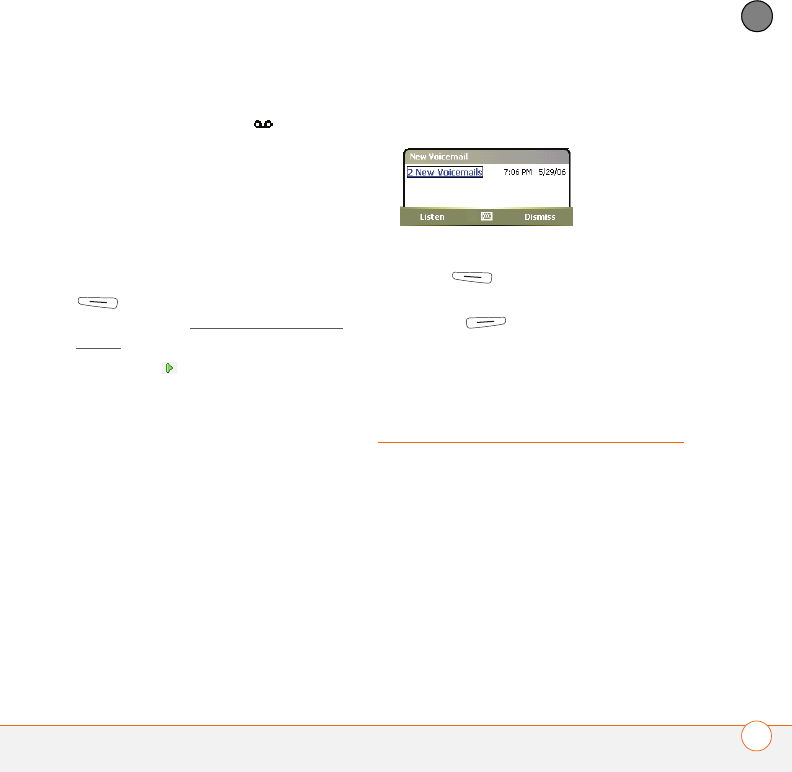
YOUR PHONE
WHAT CAN I DO DURING A CALL? 41
3
CHAPTER
When you have unretrieved voicemail
messages, a Voicemail icon appears at
the top of your screen.
1Go to your Today screen.
2Press and hold 1 on the keyboard to dial
your network operator’s voicemail
system.
3Enter your voicemail password using
the keyboard, or press Extra Digits
(left action key) if you defined
this option (see Creating a speed-dial
button for details).
4Select Play to listen to your
messages.
Retrieving messages from a voicemail
notification
NOTE Not all service plans support
voicemail notification. Check with your
network operator for more information.
You can retrieve voicemail messages when
you receive a notification or you can
dismiss the notification and retrieve the
messages later.
•When you have a new voicemail
message, a notification screen appears.
•To hear your message now, press
Listen (left action key).
•To retrieve your message later, press
Dismiss (right action key).
What can I do during
a call?
Your Palm® Treo™ 750v smartphone offers
many advanced telephone features,
including call waiting, six-way
conferencing, and call forwarding. These
features depend on your service plan.
Please contact your network operator for
more information.
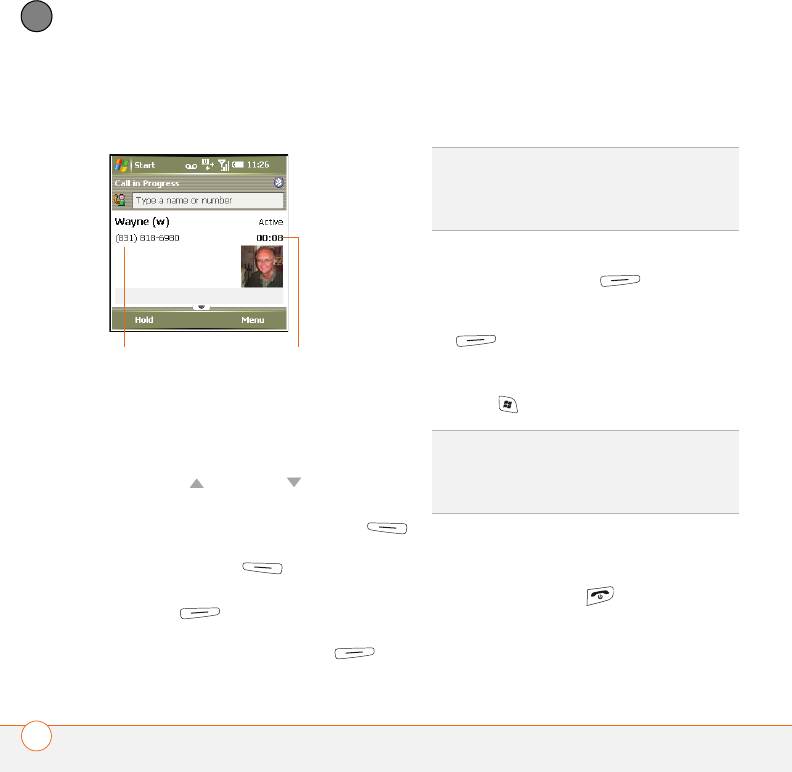
YOUR PHONE
WHAT CAN I DO DURING A CALL?
42
3
CHAPTER
When you make or receive a call, the call
info appears on your Today screen.
During a call, you can do any of the
following:
•Navigate around the Today screen:
Use Up and Down to move
around or highlight items.
•Put the call on hold: Press Hold
(left action key). To take the call off hold,
press Off Hold (left action key).
•Use the built-in speakerphone: Press
Menu (right action key) and
select Speakerphone. To use the
earpiece again, press Menu
(right action key) again and select
Speakerphone Off.
•Mute the microphone so you can’t be
heard: Press Menu (right action
key)) and select Mute. To turn the
microphone back on, press Menu
(right action key) again and select
Cancel Mute.
•Switch to another application: Press
Start and select the application.
Ending a call
Do one of the following:
•Press Power/End .
•Press the headset button (if the headset
is attached and has a button on it).
Some headsets do not have a button.
Current duration
of call
Caller’s name
and number
DID
YOU
KNOW
?
You can send and receive text
messages during a call. This is a great way to
stay connected with colleagues during a long
call.
DID
YOU
KNOW
?
When a call lasts longer than
one minute, the screen dims. After two
minutes, it dims more. Press any key, except
Power/End, to light up the screen.
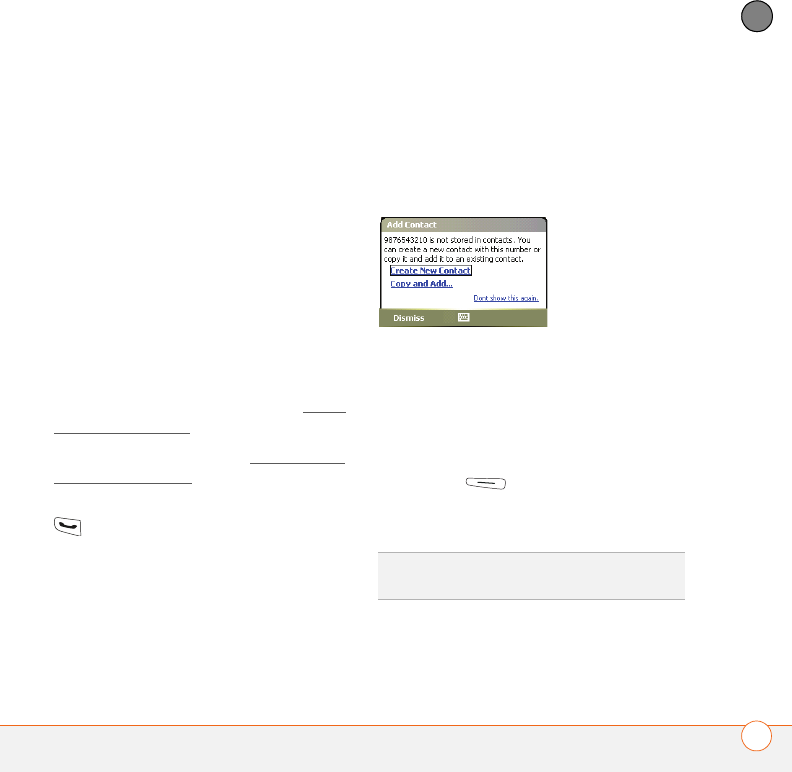
YOUR PHONE
WHAT CAN I DO DURING A CALL? 43
3
CHAPTER
Switching applications during an active
call
You can use many other applications on
your smartphone while holding a phone
conversation, including the organizer and
text message features. You cannot,
however, make some data connections
during an active call while connected to a
GPRS network. If you’re connected to a
GPRS network, you cannot browse the
web, or send and receive email or MMS
messages while on a voice call. If you’re
connected to a UMTS network, you can
perform simultaneous voice and data
functions. How can you tell which kind of
network you’re connected to? See What
are all those icons?
To open an application, see Opening and
closing applications.
From any application, press Phone/Send
to return to your Today screen.
Saving phone numbers
After you hang up, you can add the number
to Contacts if it's not already in your list. If
an incoming call uses caller ID blocking,
you do not see the Add Contact prompt.
•To create a new contact for this number,
select Create New Contact.
•To add this number to an existing
contact, select Copy and Add, and
then select a contact name.
•To decline adding the number, press
Dismiss (left action key).
•To permanently disable the Add Contact
prompt, select Don’t show this again.
TIP
You can also save contact info from other
applications, such as Messaging.
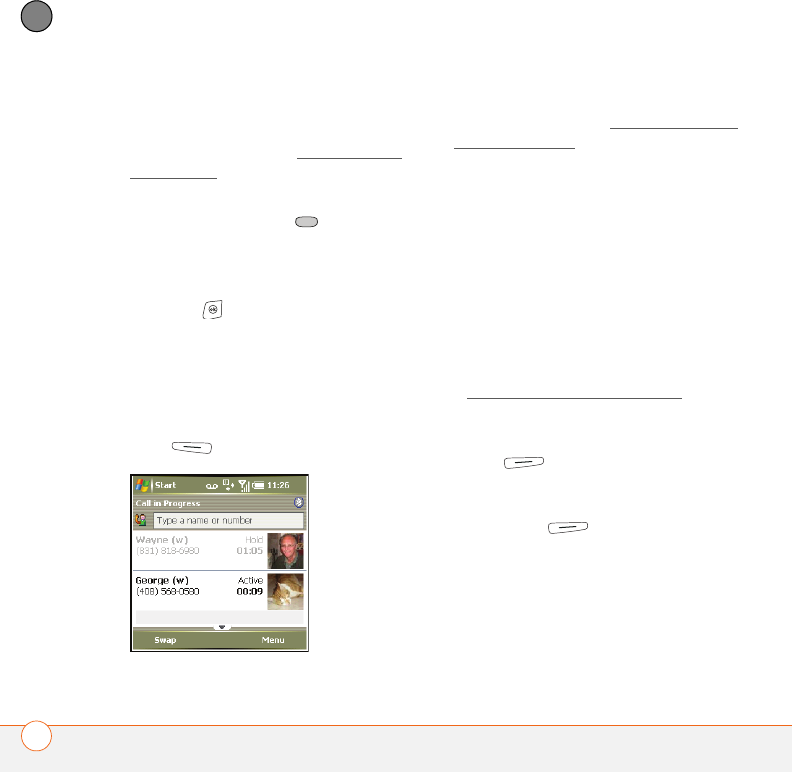
YOUR PHONE
WHAT CAN I DO DURING A CALL?
44
3
CHAPTER
If you don’t add a number right away, follow
these steps to add it later:
1Go to the Call Log (see Other ways of
making calls).
2Highlight the number you want to save.
3Press and hold Center to open the
shortcut menu, and then select Save to
Contacts.
4Enter the information for the entry.
5Press OK .
Making a second call
You can make a second call while your first
call is still active:
1Place your first call on hold by pressing
Hold (left action key).
2Dial a second number using any of the
methods described in Making calls from
the Today screen. If you’re dialing by
contact name or with the keyboard, you
must first use the 5-way to select the
Dial Lookup field.
When two calls are active, your Today
screen includes two call status sections,
each representing one of the calls.
Answering a second call (call waiting)
When you’re on a call and you receive a
second call, the call waiting notification
appears if you have chosen to be notified
(see Setting call waiting notification). You
can do any of the following:
•Send the new call to voicemail: Press
Menu (right action key) and
select Ignore.
•Send the new caller a text message:
Press Menu (right action key)
and select Ignore with text message.
The second call is sent to voicemail. A
new text message opens with the
phone number of the caller entered in
the To field.
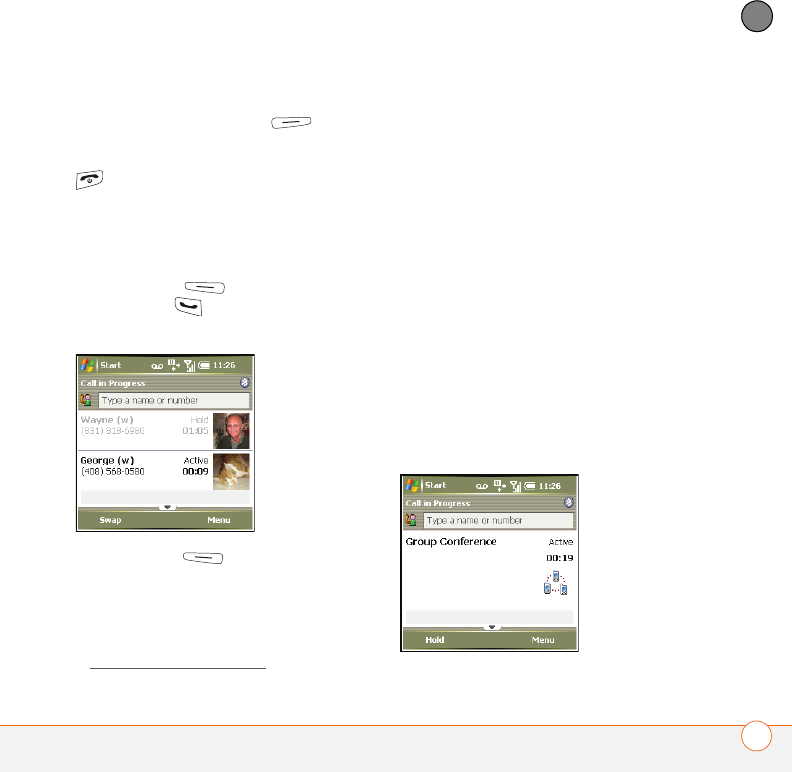
YOUR PHONE
WHAT CAN I DO DURING A CALL? 45
3
CHAPTER
•Hang up the current call and answer
the new call: Press Menu (right
action key)) and select Drop and
Answer. You can also press Power/End
to hang up the current call, and
then choose to answer or ignore the
new call.
•Place the current call on hold and
answer the new call:
Press Answer (left action key) or
Phone/Send . Once you have
answered the call:
•Press Swap (left action key) to
move between callers by placing the
current active call on hold and talking
on the other line.
•Make the calls a conference call. See
Making a conference call.
Making a conference call
BEFORE YOU BEGIN Not all service plans
support the conference call feature. If
you’re not sure, check with your network
operator to confirm that your service plan
includes conference calling.
IMPORTANT You can join up to five calls
into a 6-way conference call. The number
of calls you can join in conference depends
on your service plan. Additional charges
may apply, and minutes in your mobile
account may be deducted for each call.
Please contact your network operator for
more information.
1Answer a second call or put the first call
on hold, and make a second call.
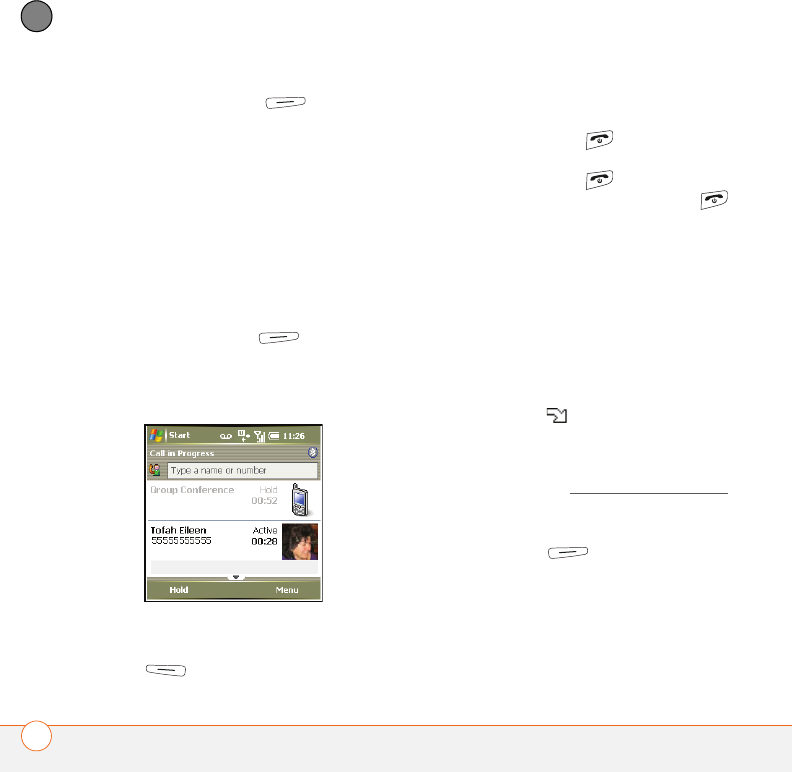
YOUR PHONE
WHAT CAN I DO DURING A CALL?
46
3
CHAPTER
2Press Conference (right action
key); this joins the two calls with you in
a conference.
3(Optional) Do one or more of the
following:
•Make more calls and join them into
the conference call. The number of
calls you can join in conference
depends on your service plan.
•Extract a caller from the conference
call to talk with them privately by
pressing Menu (right action
key), selecting Extract, and then
selecting the name. The extracted call
becomes the active call.
•Swap between the conference call
and the private call by pressing Swap
(left action key).
4When you’re done, do one of the
following: If there is no private call,
press Power/End , to end the
conference call. If there is a private call,
press Power/End once to end the
private call, and press Power/End
twice to end all calls.
Forwarding calls
You can forward calls to another phone
number. Please check with your network
operator about availability and pricing of
forwarded calls; additional charges may
apply.
When all calls are forwarded, the call
forwarding icon appears in the title bar.
BEFORE YOU BEGIN Make sure your
phone is on and that you’re inside a
coverage area (see Turning your phone on).
1Go to your Today screen.
2Press Menu (right action key),
select Preferences, and then select
Phone Settings.
3Select the Services tab, and then select
Call Forwarding from the list.
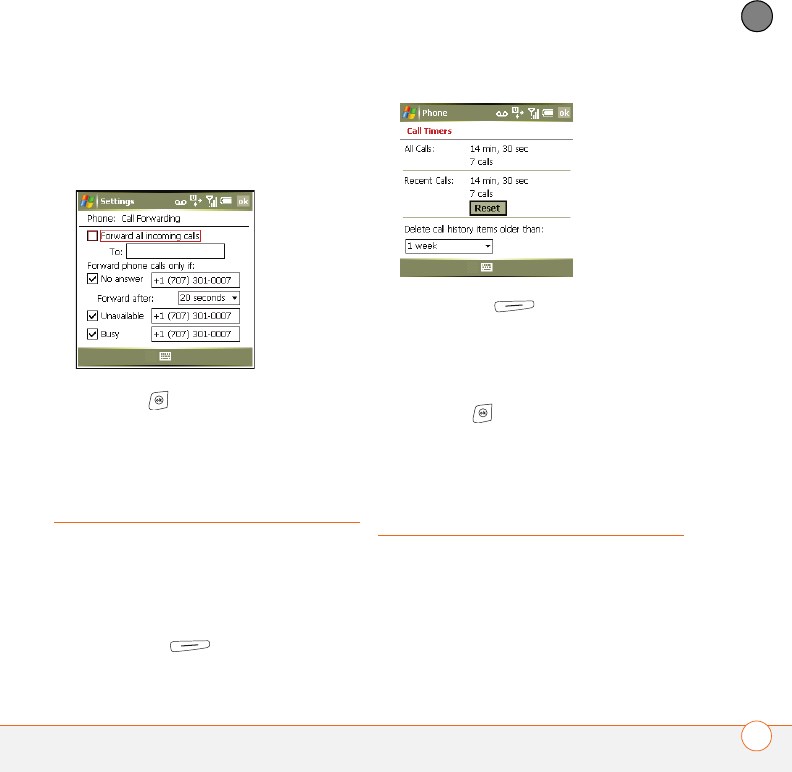
YOUR PHONE
HOW MANY MINUTES HAVE I USED? 47
3
CHAPTER
4Set your call forwarding settings. Some
of the settings are already set by your
network operator to send your calls to
Voicemail.
5Press OK .
How many minutes
have I used?
Keep in mind that your billing statement
may vary slightly from the information you
see onscreen. Usage is charged based on
your calling plan, and calling plans vary.
1Press Menu (right action key)
and select Call Log.
2Press Menu (right action key)
and select Call Timers to view voice
minutes.
3(Optional) To reset the Recent Calls
counter to zero, select Reset.
4Press OK .
Defining speed-dial
buttons
Your smartphone enables you to create
both picture and text speed-dial buttons so
that you can select a button on the Today
screen to quickly dial a number.
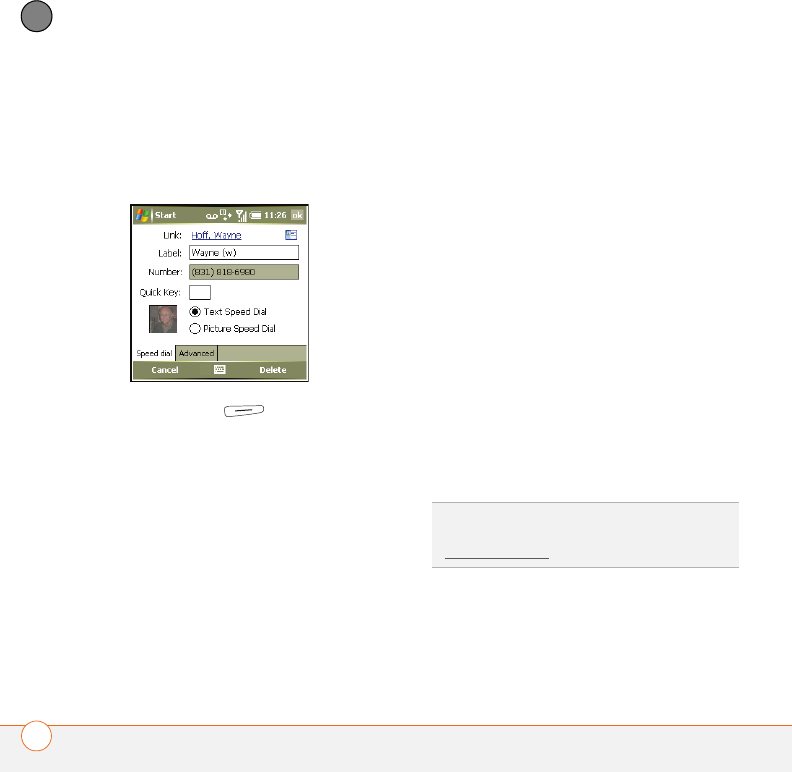
YOUR PHONE
DEFINING SPEED-DIAL BUTTONS
48
3
CHAPTER
Creating a speed-dial button
You can create up to 20 picture buttons and
50 text buttons.
1Go to your Today screen.
2Press Menu (right action key)
and select New Speed Dial.
3Do one of the following:
•Select Link to contact, select the
contact you want to link to this button,
and then select the number you want
to dial with this button.
•Select Label and enter a name for this
button, and then select Number and
enter the phone number you want to
dial with this button.
4(Optional) Enter a Quick Key. When the
Today screen is showing, you can press
and hold the Quick Key to instantly dial
this number.
Quick Keys can be letters or numbers,
but you can’t use both the letter and
number on the same key. For example,
the voicemail Quick Key is 1. The letter
equivalent for that key is E, so you
cannot assign E as a Quick Key to
another speed-dial button.
5If this button is linked to a contact entry
with a picture, select either Text Speed
Dial or Picture Speed Dial to indicate
which type of button you want to
create. If this button is not linked to a
contact or the contact doesn’t have a
picture, the Picture Speed Dial option is
not available.
TIP
You can add a special ringtone to a contact
associated with the speed-dial button. See
Adding a contact.
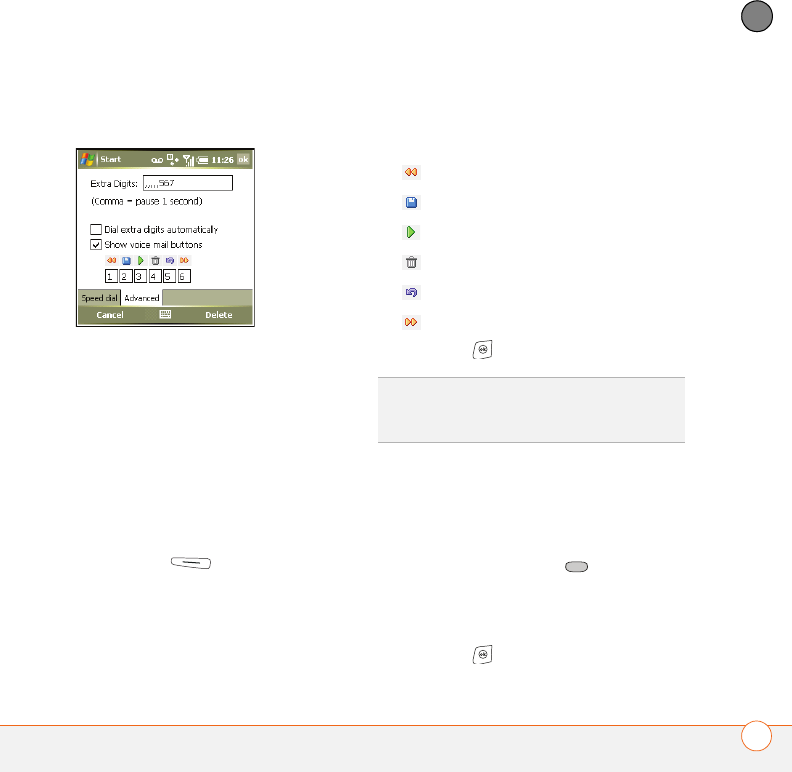
YOUR PHONE
DEFINING SPEED-DIAL BUTTONS 49
3
CHAPTER
6(Optional) Select the Advanced tab and
set any of the following options:
Extra Digits: Defines additional
numbers to dial, such as a password or
extension. In addition to numbers, you
can enter the following symbols: star
(*) and pound (#). To enter a one-
second pause, enter a comma (,).
Dial extra digits automatically: Dials
predefined Extra Digits immediately
after dialing the phone number. If you
do not check this box, you need to press
Extra Digits (left action key) to
dial these digits.
Show voice mail buttons: Displays the
voicemail playback controls after you
dial this speed-dial number. When this
option is checked, you can enter
numbers below each control to tailor
the controls to your voicemail system.
Plays the previous message.
Saves the current message.
Plays the current message.
Deletes the current message.
Repeats the current message.
Plays the next message.
7Press OK .
Editing a speed-dial button
1Go to your Today screen.
2Highlight the speed-dial button you
want to edit.
3Press and hold Center to open the
shortcut menu, and then select Edit
Speed Dial.
4Make the desired changes.
5Press OK .
DID
YOU
KNOW
?
The playback controls for your
network operator’s Voicemail speed-dial
button are already set up.

YOUR PHONE
USING A PHONE HEADSET
50
3
CHAPTER
Deleting a speed-dial button
1Go to your Today screen.
2Highlight the speed-dial button you
want to delete.
3Press and hold Center to open the
shortcut menu, and then select Edit
Speed Dial.
4Press Delete (right action key).
5Select Ye s to confirm the deletion.
Arranging your speed-dial buttons
1Go to your Today screen.
2Press Menu (right action key)
and select Speed Dial Options.
3Highlight the button you want to move.
4Press Option + Left or Right or
Up or Down to move the button
in that direction.
Using a phone
headset
You can connect a phone headset for
hands-free operation. You can use the
headset that came with your smartphone
or compatible third-party headsets.
IMPORTANT If driving while using a
smartphone is permitted where you are
and you need to make a call, we
recommend using a phone headset or a
hands-free car kit (sold separately). If you
must use the wired headset while driving,
place a speaker in only one ear. Leave the
other ear free to hear outside noises. Make
such a call only if it is legal to do so and you
can do so safely.
TIP
You can also edit a speed-dial button by
pressing Menu and selecting Speed Dial
Options, and then selecting the button you
want to edit.
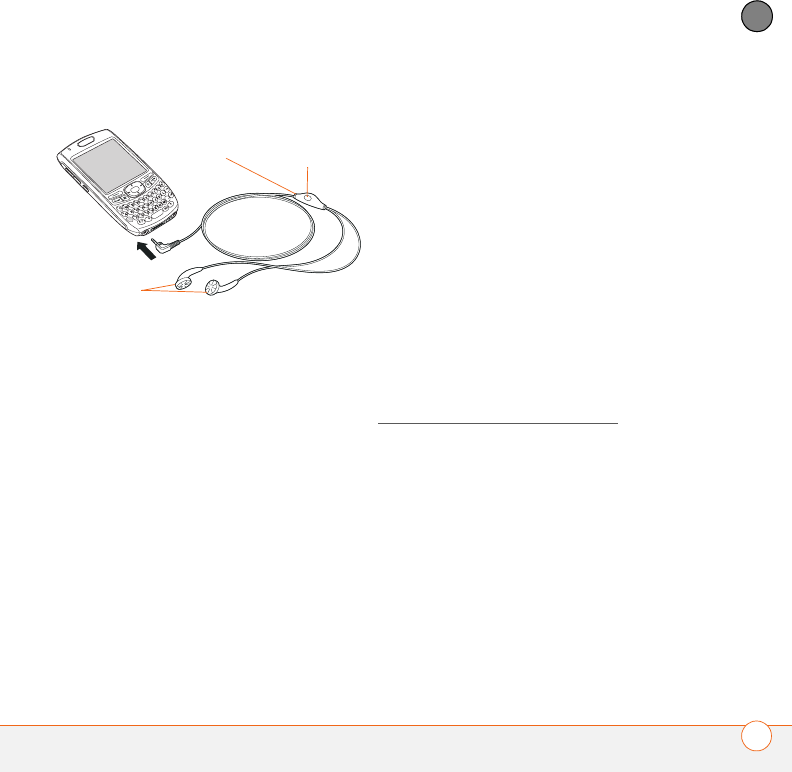
YOUR PHONE
USING A PHONE HEADSET 51
3
CHAPTER
Using a wired headset
The headset button is context-sensitive,
and it performs various actions based on
the situation. You can press the headset
button to perform any of the following
tasks:
•Answer an incoming call
•Respond to call waiting
•Hang up all calls
•Swap between calls
NOTE Your smartphone works with
headsets that have a 2.5mm, 3-pin
connector (look for two colored bands on
the plug). When in doubt, ask the
third-party headset manufacturer if the
product is compatible with Palm® Treo™
750v smartphones. If you hear a headset
buzz or poor microphone performance,
your headset may be incompatible with
your smartphone.
Connecting to a Bluetooth® hands-free
device
Your smartphone is also compatible with
many headsets and car kits (sold
separately) enabled with Bluetooth®
wireless technology version 1.1 or 1.2.
For a list of compatible hands-free devices
with Bluetooth wireless technology, go to
www.palm.com/treo750v-support.
After you set up a connection with a
Bluetooth headset or hands-free car kit,
you can communicate with that device
whenever it is within range and your
smartphone’s Bluetooth feature is turned
on. The range varies greatly, depending on
environmental factors; the maximum is
about 10 meters (30 feet).
Microphone
Speakers
Headset button
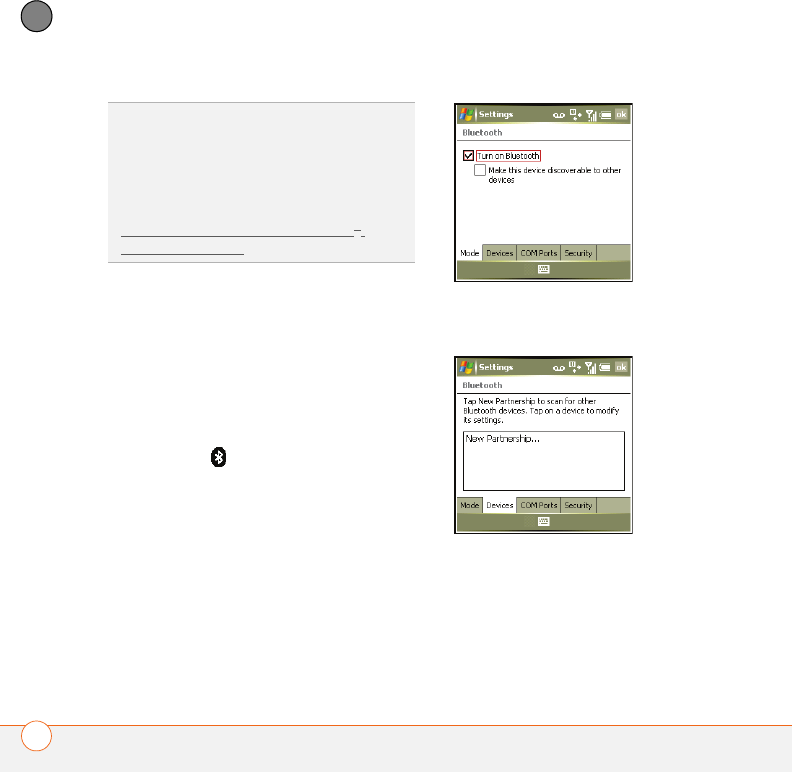
YOUR PHONE
USING A PHONE HEADSET
52
3
CHAPTER
1If necessary, prepare the device you
want to connect with to accept a new
connection. Check the device’s
documentation for details; be sure to
find out if the device has a predefined
passkey that you need to enter on your
smartphone in step 7.
2Go to your Today screen, and then tap
Bluetooth .
3Check the Turn on Bluetooth box to
turn on your smartphone’s Bluetooth
feature.
4Select the Devices tab, and then select
New Partnership.
DID
YOU
KNOW
?
If you have both a compatible
Bluetooth headset and car kit, the one you
connected to your smartphone last becomes
the active device.
TIP
For information on making Bluetooth
connections with other types of devices, see
Connecting to devices with Bluetooth®
wireless technology.
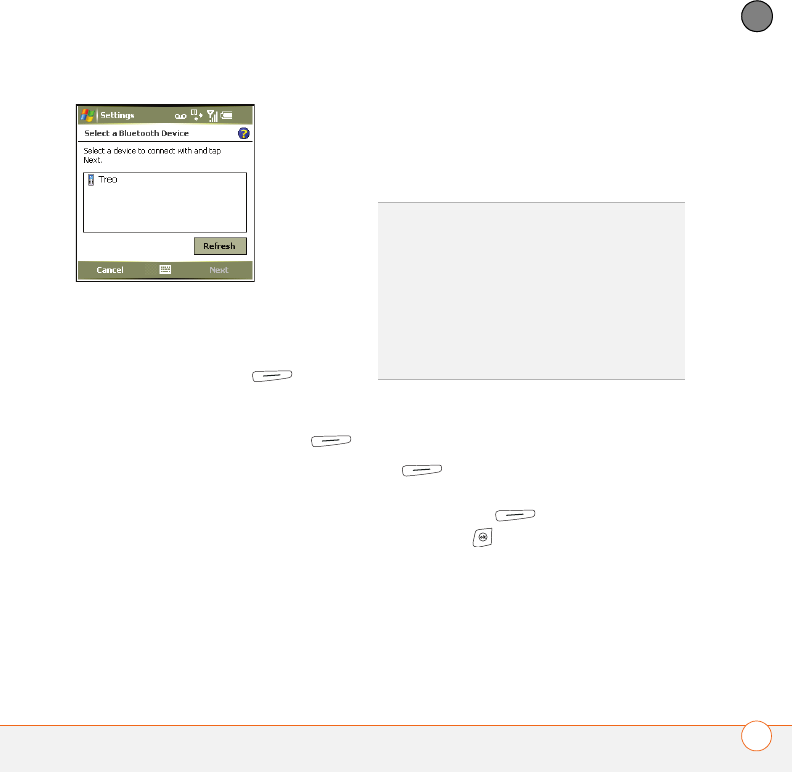
YOUR PHONE
USING A PHONE HEADSET 53
3
CHAPTER
5Wait for your smartphone to search for
devices and to display the device list.
6Select the device you want to connect
to, and then press Next (right
action key).
7Enter a passkey between 1 and 16
digits long, and then press Next
(right action key).
IMPORTANT Some hands-free devices
have a predefined passkey; if so, you can
find the passkey in the documentation for
that device. Other devices provide a screen
where you enter a passkey that you make
up. In either case, you must use the same
passkey on both your smartphone and your
hands-free device. We recommend that
where possible, you make up a passkey of
16 alphanumeric characters (letters and
numerals only) to improve the security of
your smartphone. The longer the passkey,
the more difficult it is for the passkey to be
deciphered.
8If the passkey is not predefined, enter
the same passkey on the other
Bluetooth device, and then press Finish
(right action key).
9Check the Hands Free box, and then
press Finish (right action key).
10 Press OK .
You can now communicate with this device
whenever it is within range and your
smartphone’s Bluetooth feature is turned
on. The range varies greatly, depending on
environmental factors; the maximum is
about 10 meters (30 feet).
DID
YOU
KNOW
?
The Bluetooth icon on your
Today screen indicates the status of your
smartphone’s Bluetooth feature:
Gray = Bluetooth off.
Blue = Bluetooth on.
White = Connected to a Bluetooth device.
Headset icon = Call in progress with a
Bluetooth headset or car kit.
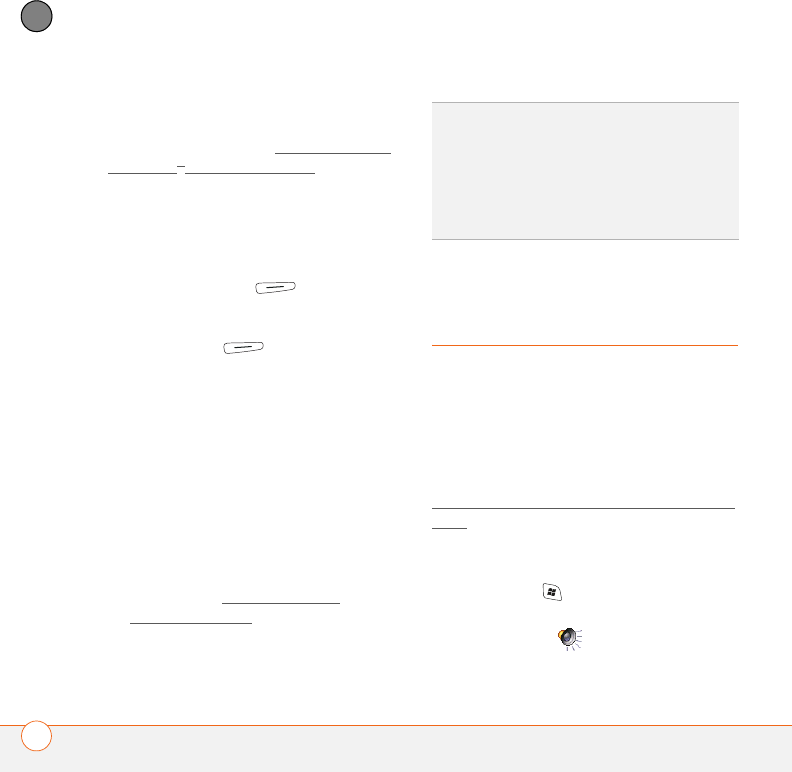
YOUR PHONE
CUSTOMIZING PHONE SETTINGS
54
3
CHAPTER
Using a Bluetooth hands-free device
To learn how to set up and connect to
Bluetooth devices, see Connecting to a
Bluetooth® hands-free device.
Here are tips for working with a Bluetooth
hands-free device:
•To transfer a call from the handset to a
Bluetooth hands-free device during a
call, press Menu (right action
key) and select Connect Bluetooth. To
transfer the call back to the headset,
press Menu (right action key)
and select Cancel Bluetooth.
•To transfer a call from a wired headset
to a Bluetooth headset or car kit that is
within range and with which you’ve
previously set up a partnership
(Bluetooth headset or car kit required,
sold separately), unplug the wired
headset and press the button on the
Bluetooth headset or car kit.
•To find out how to transfer your
contacts from your smartphone to your
car kit, go to www.palm.com/
treo750v-support.
Customizing phone
settings
Selecting ringtones and display notices
You can set different tones for different
types of incoming phone calls and
notifications. You can download MP3,
MIDI, AMR, WAV, and WMA ringtones
directly to your smartphone (see
Downloading files and images from a web
page). You can also download ringtones to
your computer and then email them to your
phone.
1Press Start and select Settings.
2On the Personal tab, select Sounds &
Notifications .
3Select the Notifications tab.
DID
YOU
KNOW
?
If you’re using a Bluetooth
hands-free device and it is within range, your
smartphone routes all calls to the hands-free
device instead of to your smartphone’s
earpiece. Bluetooth range is up to 10 meters
(30 feet) in optimum environmental
conditions.
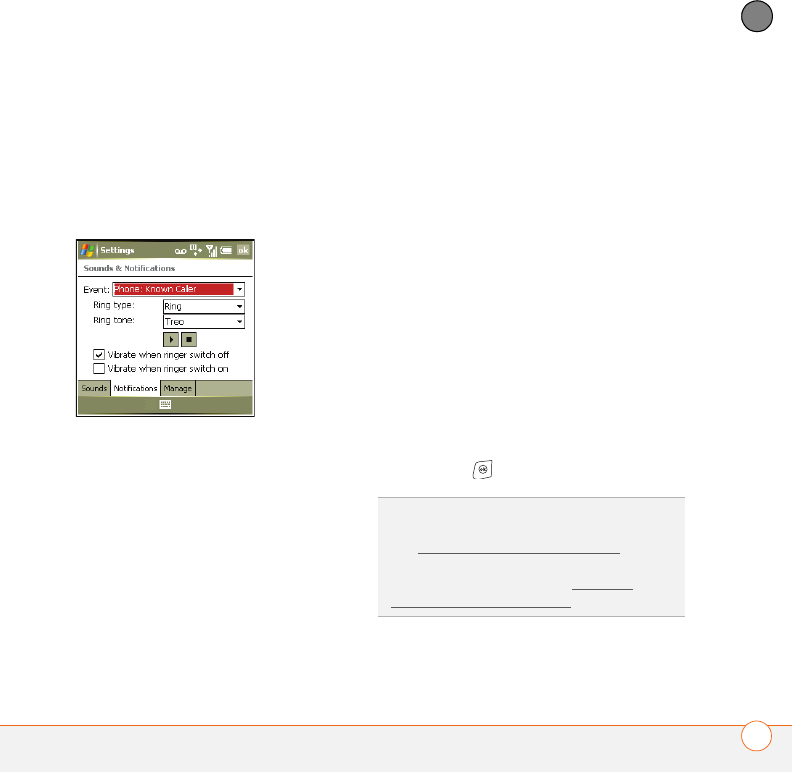
YOUR PHONE
CUSTOMIZING PHONE SETTINGS 55
3
CHAPTER
4Select the Event, and then select which
type of call or notification you want to
set the ringtone for:
Phone: Known Caller: An incoming call
from someone in your Contacts list or
Speed Dial list.
Phone: Missed call: A call you did not
answer.
Phone: Roaming: A call that comes in
when you’re outside your home mobile
network.
Phone: Unknown Caller: An incoming
call from someone identified by caller
ID who is not in your Contacts list or
Speed Dial list.
Phone: Voice mail: A new voicemail.
5Check the Play Sound box if you want
to have a sound played when the event
occurs.
6If you checked the Play Sound box,
then select the sound for the selected
type of call. You can also check the
Repeat box to have the sound repeat.
7(Optional) Select the Play icon to
preview the sound.
8Check the Display message on screen
box to have a message displayed when
the event occurs.
9Check the Vibrate when… boxes to
turn the vibrate feature on/off based on
the ringer switch setting.
10 Repeat steps 4–9 to select ringtones for
other types of calls.
11 Press OK .
DID
YOU
KNOW
?
You can record, preview,
delete, and send sounds on your smartphone.
See Selecting Sounds & Notifications. You can
also set sounds for messaging notifications
and calendar reminders. See Selecting
ringtones and display notices.
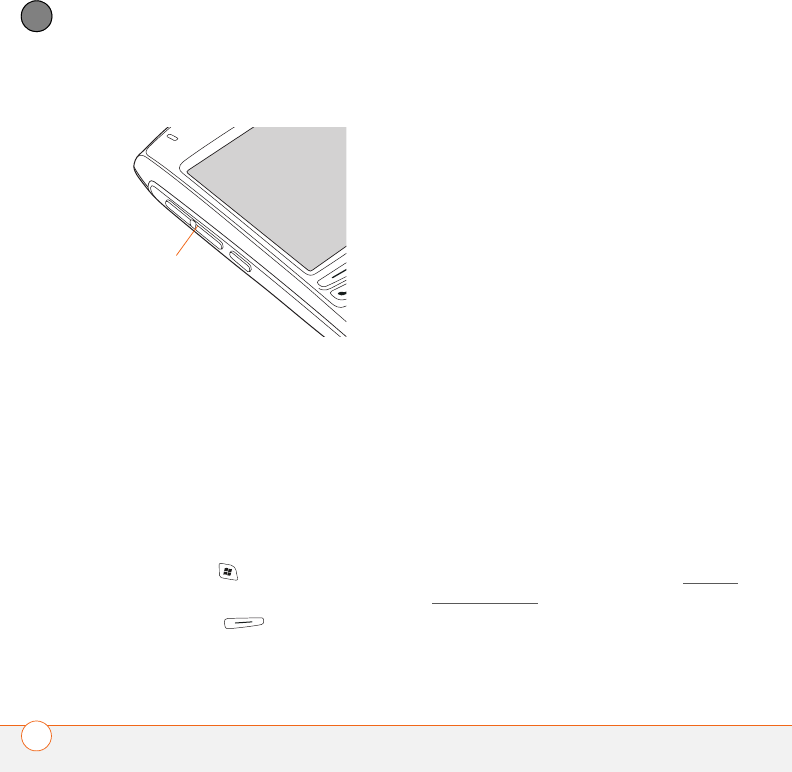
YOUR PHONE
CUSTOMIZING PHONE SETTINGS
56
3
CHAPTER
Adjusting call and ringer volume
•Call volume: While a call is in progress,
press the Volum e button (on the side of
your smartphone) to adjust the call
volume.
•Ringer volume: When a call is not in
progress and you are not playing music
or a video, press the Volume button to
adjust ringer volume.
Assigning a caller ID ringtone
1Press Start and select Contacts.
2Select the contact’s name.
3Press Menu (right action key)
and select Edit.
4Select Ring tone.
5Select a tone for this contact entry.
6Select OK.
Enabling TTY
You can enable your smartphone for use
with a TTY/TDD device. A TTY (also known
as a TDD or Text Telephone) is a
telecommunications device that enables
people who are deaf or hard of hearing, or
who have speech or language disabilities,
to communicate by telephone.
Your smartphone is compatible with select
TTY devices. You can connect a TTY/TDD
machine, headset, or hands-free kit to your
smartphone through the headset jack while
in TTY/TDD mode. Please check with the
manufacturer of your TTY device for
connectivity information. Be sure that the
TTY device supports digital wireless
transmission.
BEFORE YOU BEGIN Turn on your phone
to access your Phone Settings. See Turning
your phone on..
Volume button
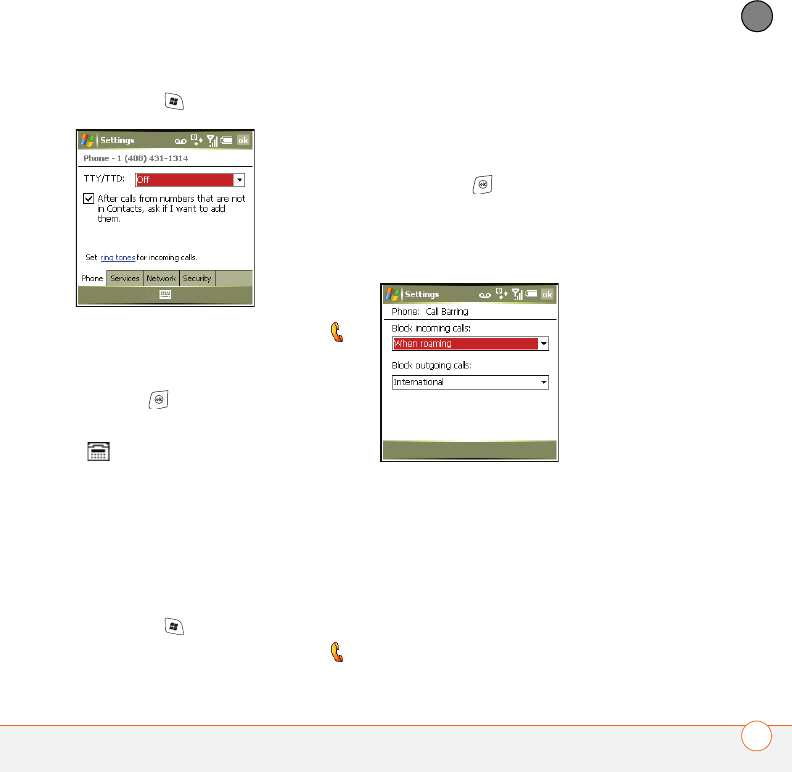
YOUR PHONE
CUSTOMIZING PHONE SETTINGS 57
3
CHAPTER
1Press Start and select Settings.
2On the Personal tab, select Phone .
3On the Phone tab, select TTY/TDD,
and then select either On or Off.
4Press OK .
NOTE When TTY/TDD is on, a TTY/TDD
icon appears at the top of the Today
screen.
Adding Contacts numbers from new
callers
You are prompted to add contact entries for
numbers that are not already in your
Contacts list.
1Press Start and select Settings.
2On the Personal tab, select Phone .
3On the Phone tab, check the After calls
from numbers that are not in
Contacts, ask if I want to add them
box.
4Press OK .
Blocking calls
You can block incoming or outgoing calls.
BEFORE YOU BEGIN You need to do the
following:
•Make sure that call barring is supported
by your service plan. Check with your
network operator for more information.
•Get a call barring password from your
network operator.
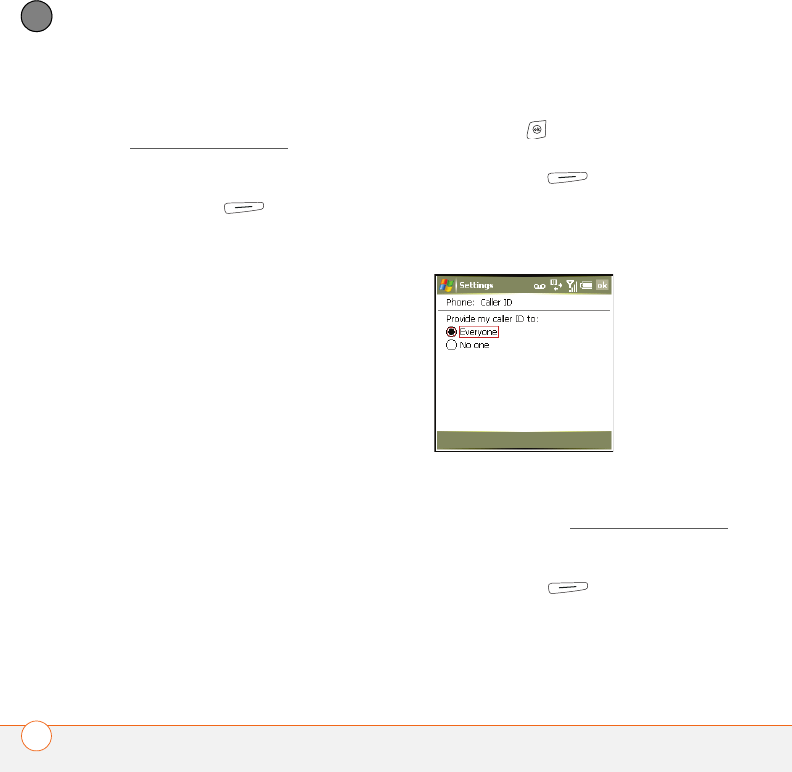
YOUR PHONE
CUSTOMIZING PHONE SETTINGS
58
3
CHAPTER
•Make sure your phone is on and that
you’re inside a coverage area (see
Turning your phone on).
1Go to your Today screen.
2Press Menu (right action key),
select Preferences, and then select
Phone Settings.
3Select the Services tab, and then select
Call Barring from the list.
4Select the Block incoming calls list,
and then select one of the options:
Off: No incoming calls are blocked.
When roaming: All incoming calls are
blocked when roaming.
All calls: All incoming calls are blocked.
5Select the Block outgoing calls list,
and then select one of the options:
Off: No outgoing calls are blocked.
International: All outgoing international
calls are blocked.
International except to home
country: All outgoing international calls
are blocked except to the country
where the phone is based.
All calls: All outgoing calls are blocked.
6Press OK .
7Enter the call barring password and
select Done (right action key).
Setting caller ID
You can turn caller ID on or off.
BEFORE YOU BEGIN Make sure your
phone is on and that you’re inside a
coverage area (see Turning your phone on).
1Go to your Today screen.
2Press Menu (right action key),
select Preferences, and then select
Phone Settings.
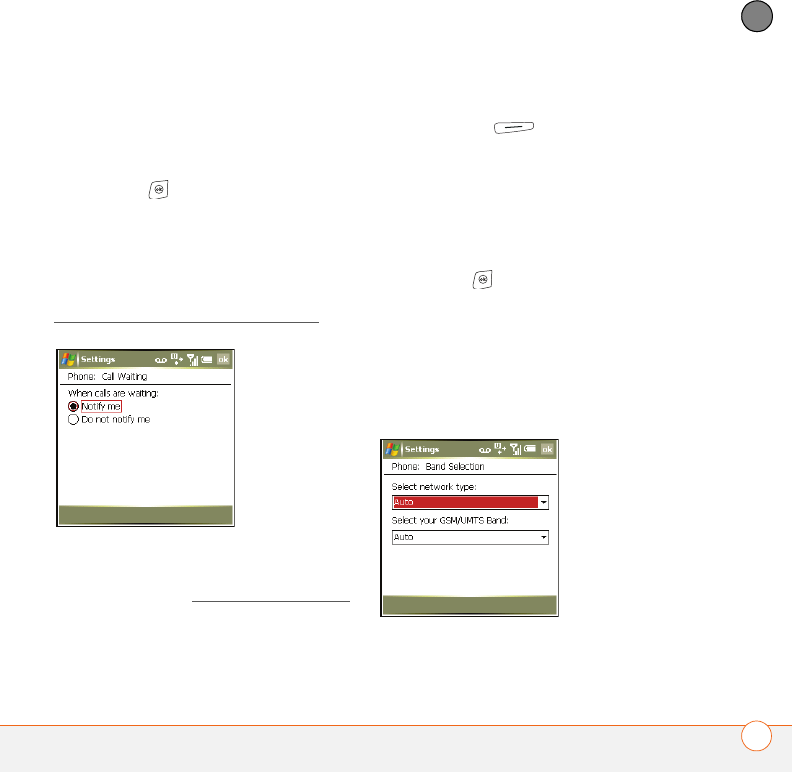
YOUR PHONE
CUSTOMIZING PHONE SETTINGS 59
3
CHAPTER
3Select the Services tab, and then select
Caller ID from the list.
4Check the appropriate box to provide
your caller ID to Everyone or No one.
5Press OK .
Setting call waiting notification
You can choose to be notified when you
receive a call while you are on a call. You
can choose to accept the call or not. See
Answering a second call (call waiting).
BEFORE YOU BEGIN Make sure your
phone is on and that you’re inside a
coverage area (see Turning your phone on).
1Go to your Today screen.
2Press Menu (right action key),
select Preferences, and then select
Phone Settings.
3Select the Services tab, and then select
Call Waiting from the list.
4Check the appropriate box to receive
notification or not.
5Press OK .
Manually selecting your wireless band
The wireless band setting is preset for
optimum performance. Do not change this
setting unless instructed to do so by your
network operator’s representative.
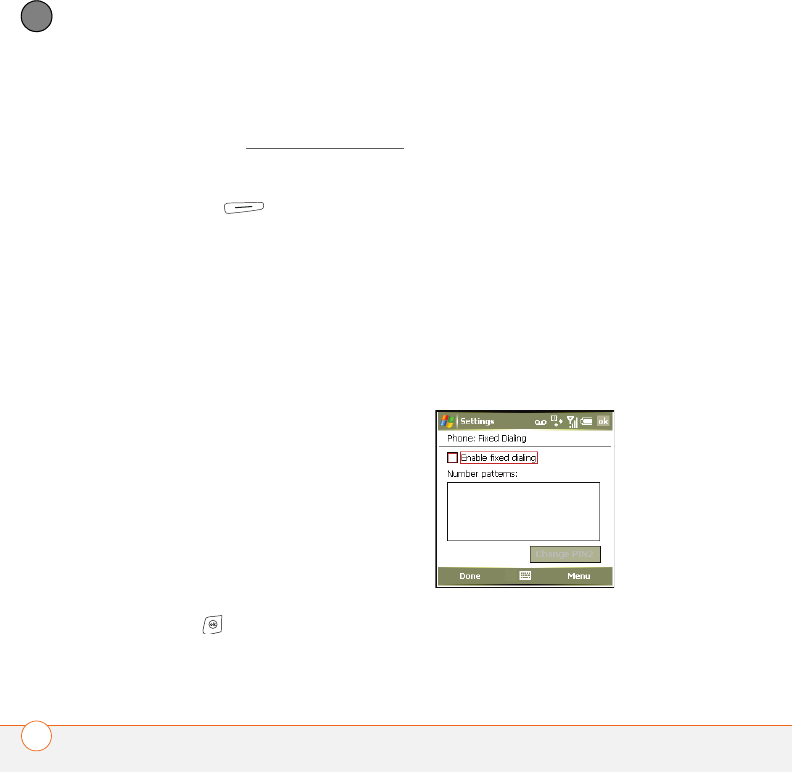
YOUR PHONE
CUSTOMIZING PHONE SETTINGS
60
3
CHAPTER
BEFORE YOU BEGIN Make sure your
phone is on and that you’re inside a
coverage area (see Turning your phone on).
1Go to your Today screen.
2Press Menu (right action key),
select Preferences, and then select
Phone Settings.
3Select the Services tab, and then select
Band Selection from the list.
4Select the Select network type list,
and and select one of the following:
Auto: Automatically selects a network.
GSM: Connects only to GSM networks.
UMTS: Connects only to UMTS
networks.
5Select the Select your GSM/UMTS
Band list, and then select one of the
bands:
Auto
GSM (900+1800) + UMTS 2100
GSM (1900+850) + UMTS (1900+ 850)
6Press OK .
Enabling fixed dialing
Fixed dialing allows you to restrict your
outgoing calls and messages to selected
phone numbers, included in your fixed
dialing list. Once the service is activated,
you can call and send messages only to the
phone numbers from the list.
The list is protected by a PIN2. If you enter
an incorrect PIN2 more times than allowed
by your network operator, the SIM card
locks. Once the SIM card locks, you need
the PUK2 to unlock the SIM card. Contact
your network operator for more
information and the PUK2.
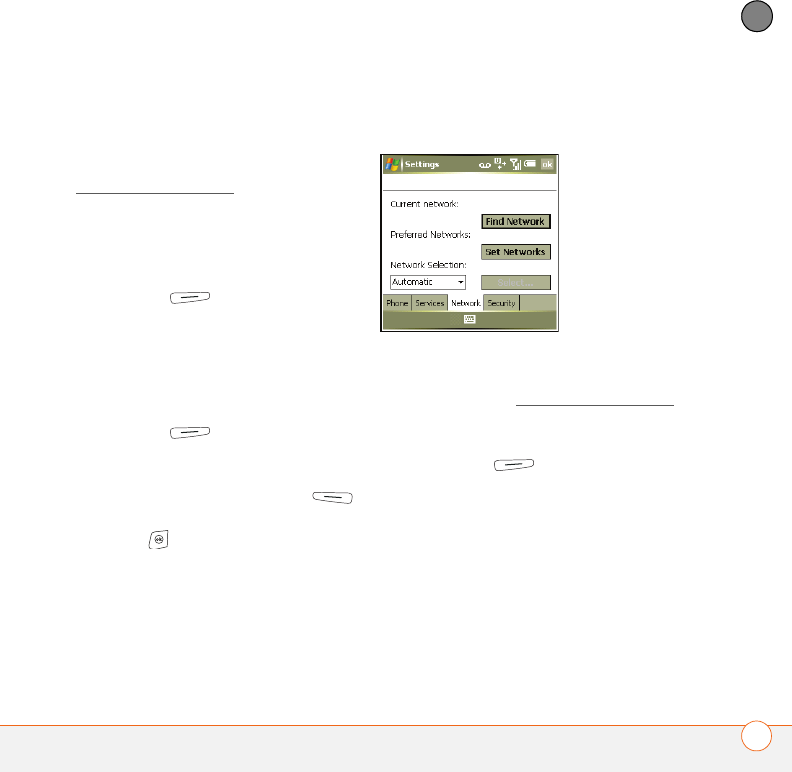
YOUR PHONE
CUSTOMIZING PHONE SETTINGS 61
3
CHAPTER
BEFORE YOU BEGIN You need the
following:
•Make sure your phone is on and that
you’re inside a coverage area (see
Turning your phone on).
•Get your PIN2 from your network
operator.
1Go to your Today screen.
2Press Menu (right action key),
select Preferences, and then select
Phone Settings.
3Select the Services tab, and then select
Fixed Dialing from the list.
4Check the Enable fixed dialing box.
5Press Menu (right action key) to
add, delete, or edit the phone numbers
in the list.
6Enter your PIN2 and press Done
(left action key).
7Press OK .
Manually selecting your network settings
The network setting is preset for optimum
performance. Do not change this setting
unless instructed to do so by your network
operator’s representative.
BEFORE YOU BEGIN Make sure your
phone is on and that you’re inside a
coverage area (see Turning your phone on).
1Go to your Today screen.
2Press Menu (right action key),
select Preferences, and then select
Phone Settings.
3Select the Network tab.
4To switch to another network, select
Find Network and select an available
network.
5To change your preferred network,
select Set Networks, check the box
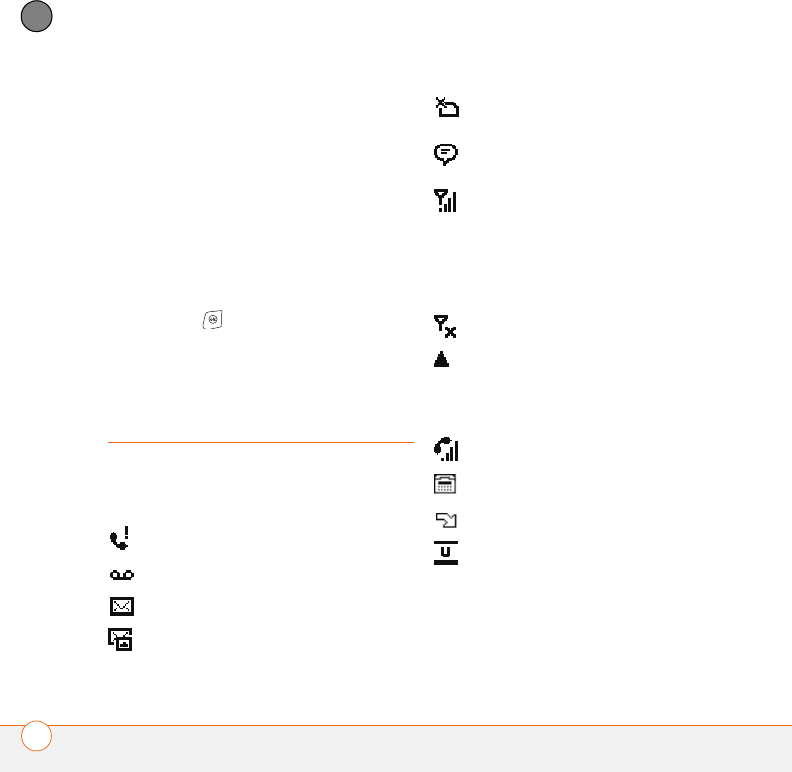
YOUR PHONE
WHAT ARE ALL THOSE ICONS?
62
3
CHAPTER
next to the networks you want, and
then select your order of preference.
6From the Network Selection list, select
an option:
•Automatic: The network connection
is automatically made.
•Manual: Network connections are
manually made. If you are manually
selecting a network, select a network
from the list of available networks.
7Press OK .
What are all those
icons?
You can monitor the status of several items
using icons at the top of your Today screen:
You missed an incoming call.
You have a voicemail message.
You have a new email message.
You have a new text, or
multimedia message.
No SIM inserted in device or
software unable to find SIM.
You have more than one of the
conditions listed above.
Your phone is on. The bars
display the signal strength.
The stronger the signal, the
more bars appear. If you are
outside a coverage area, no bars
appear.
Your phone is off.
You are outside your network
operator’s coverage area and
roaming on another network
operator’s network.
A voice call is in progress.
TTY/TDD is turned on.
All calls are being forwarded.
Your phone is connected to a
UMTS network, but you are not
actively transmitting data. You
can still make or receive calls.
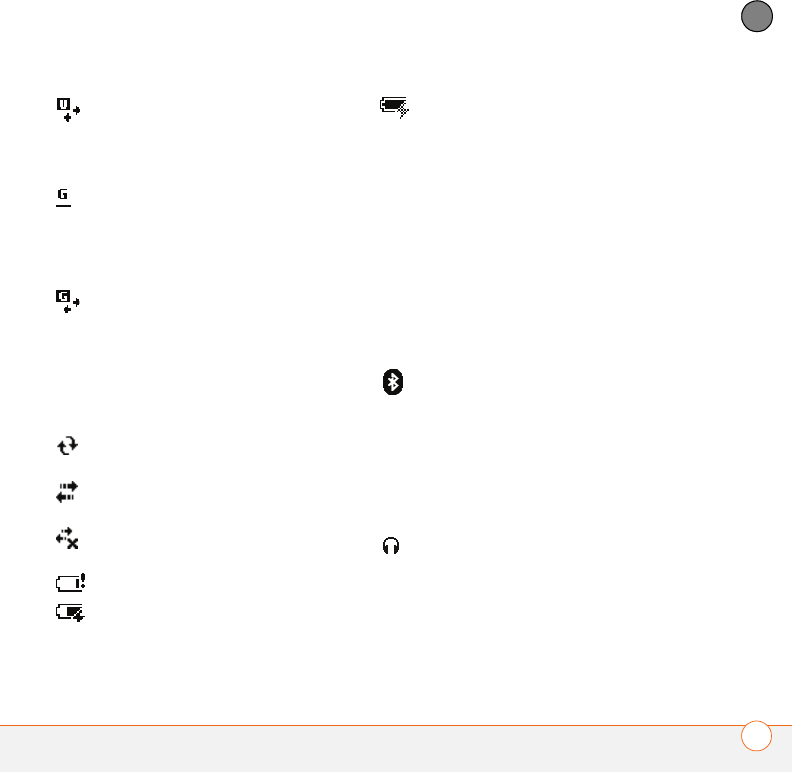
YOUR PHONE
WHAT ARE ALL THOSE ICONS? 63
3
CHAPTER
Your phone is on and a UMTS
data connection is active. You
can make and receive calls and
transmit data simultaneously.
Your phone is connected to a
GPRS (EDGE if available)
network, but you are not actively
transmitting data. You can still
make or receive calls.
Your phone is on and a GPRS
(EDGE if available) data
connection is active. You can still
make or receive calls, but the
data transmission is
automatically interrupted during
a call.
ActiveSync synchronization is in
progress.
Your smartphone is connecting
to a computer or network.
A data connection is not available
or your phone is off.
Your smartphone’s battery is low.
Your smartphone’s battery is
charging.
Your smartphone is connected to
a power outlet and the battery is
fully charged.
Network
operator
name
Your phone is on and you are in
your network operator’s
coverage area. If you are outside
a coverage area, No service or
Roaming appears instead. Data
services may not be available
when you are roaming on partner
networks. When you turn
off your phone, Phone Off
appears instead.
The Bluetooth® wireless
technology status indicator
appears in gray when this feature
is off, in blue when this feature is
on, and in reverse blue when
your smartphone
is communicating with another
Bluetooth device.
A call is in progress and your
smartphone is connected to a
Bluetooth headset or car kit.

YOUR PHONE
WHAT ARE ALL THOSE ICONS?
64
3
CHAPTER

CHAPTER
4
Synchronizing information
Synchronizing simply means that information that has been
entered or updated in one place—your smartphone, your
computer, or your corporate server—is automatically updated
in the other. There’s no need to enter information twice. Some
kinds of synchronization can happen on an automated
schedule, so you don’t even have to think about it.
After you get into the habit of synchronizing regularly, you’ll
know what a powerful tool synchronization is for transferring,
updating, and backing up large amounts of information on your
smartphone.
Benefits
•Quickly enter and update
information on your computer and
your smartphone
•Protect your information
•Send photos and videos to your
smartphone from your desktop
computer

In this chapter
How do I synchronize?. . . . . . . . . . . . . . . . . . . . . . . . . . . . . . . . . . . 68
What can I synchronize? . . . . . . . . . . . . . . . . . . . . . . . . . . . . . . . . . 69
Setting up wireless synchronization. . . . . . . . . . . . . . . . . . . . . . . . . 70
Setting up your computer for synchronization . . . . . . . . . . . . . . . . . 74
Synchronizing using the sync cable . . . . . . . . . . . . . . . . . . . . . . . . . 78
Other ways to synchronize. . . . . . . . . . . . . . . . . . . . . . . . . . . . . . . . 79
Setting synchronization options . . . . . . . . . . . . . . . . . . . . . . . . . . . . 81

SYNCHRONIZING INFORMATION
67
4
CHAPTER
This chapter discusses using Microsoft
Exchange ActiveSync® and other methods
to synchronize your smartphone and your
computer.
Synchronization enables you to enter or
change information on your smartphone or
in Microsoft Office Outlook®. Your info is
then automatically updated in both places;
there’s no need to enter the info twice.
This is true whether you sync wirelessly
with your company’s Exchange Server
using Microsoft Exchange ActiveSync (see
Setting up wireless synchronization) or
with your computer using ActiveSync
desktop software (see Setting up your
computer for synchronization).
By default, the info from the following
applications is synchronized for either
method of synchronization:
You can, however, customize sync settings
to suit your needs and sync only some of
these applications.
If you set up ActiveSync synchronization
with your computer, information in the
Favorites application is synchronized by
default as well. You can also change
settings to synchronize Word, Excel,
PowerPoint, and PDF files, as well as
pictures, music, videos, and other types of
files (see Changing which applications
sync). For synchronization of music and
videos, you also must have Windows
Media® Player 10 on your computer.
You can set up your smartphone to use any
combination of wireless sync, ActiveSync
synchronization, and Windows Media
Player sync.
DID
YOU
KNOW
?
When you sync Favorites, it
creates a folder in your computer’s web
browser called Mobile Favorites that backs up
any favorites you create in the browser on
your smartphone. You can add or remove
favorites directly to or from the folder.
TIP
If you don’t already have Windows Media
Player installed on your computer, you can
install it from the Windows Mobile Getting
Started Disc. Insert the CD into your
computer’s CD drive, select Add Programs,
and then select Windows Media Player.

SYNCHRONIZING INFORMATION
HOW DO I SYNCHRONIZE?
68
4
CHAPTER
How do I
synchronize?
There are a number of ways to make
synchronization occur. You may be able to
synchronize wirelessly with an Exchange
Server, or you can install ActiveSync
desktop software on your computer to
synchronize in one of a number of
ways.You can, of course, choose to sync
both with an Exchange Server and with
ActiveSync desktop software to maximize
your sync options.
Synchronizing wirelessly with the server
You can set up your smartphone to
synchronize wirelessly with Microsoft
Exchange Server 2003 with Service Pack 2
using Microsoft Exchange ActiveSync; see
Setting up wireless synchronization. If you
choose this method, synchronization takes
place automatically after setup; you do not
need to install the software from the
Windows Mobile Getting Started Disc,
which came with your smartphone.
NOTE We recommend that you install
ActiveSync desktop software from the CD
even if you synchronize wirelessly with the
server. You need ActiveSync to synchronize
pictures, videos, music files, and other info
directly with your computer.
Synchronizing with ActiveSync desktop
software
BEFORE YOU BEGIN Install the software
from the Windows Mobile Getting Started
Disc, which came with your smartphone.
You must install this software even if you
have already installed a previous version of
ActiveSync desktop software.
See Installing the desktop synchronization
software for instructions.
If you install ActiveSync desktop software
from the Windows Mobile Getting Started
Disc, you can choose to synchronize in any
of the following ways:
•By connecting your smartphone to your
computer using the sync cable; see
Synchronizing using the sync cable
•Wirelessly, using your smartphone’s
built-in Bluetooth® wireless technology;
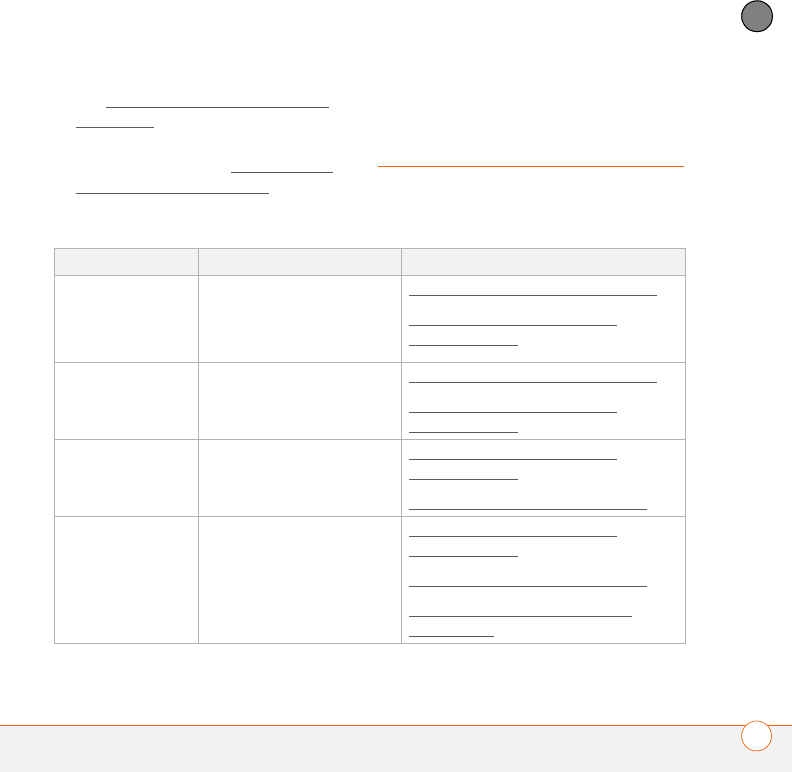
SYNCHRONIZING INFORMATION
WHAT CAN I SYNCHRONIZE? 69
4
CHAPTER
see Synchronizing over a Bluetooth
connection
•Wirelessly, using your smartphone’s
infrared (IR) port; see Synchronizing
over an infrared connection
What can I
synchronize?
This table lists the types of info you can
synchronize and the methods to use.
Info type Method Where to learn more
Outlook Contacts,
Calendar, Tasks
Exchange ActiveSync
(direct sync with server) or
ActiveSync (sync with
computer)
Setting up wireless synchronization or
Setting up your computer for
synchronization
Outlook Email Exchange ActiveSync or
ActiveSync
Setting up wireless synchronization or
Setting up your computer for
synchronization
Word, Excel,
PowerPoint, PDF
files
ActiveSync Setting up your computer for
synchronization
Changing which applications sync
Music and video
files
ActiveSync and Windows
Media Player 10
Setting up your computer for
synchronization
Changing which applications sync
Transferring media files to your
smartphone
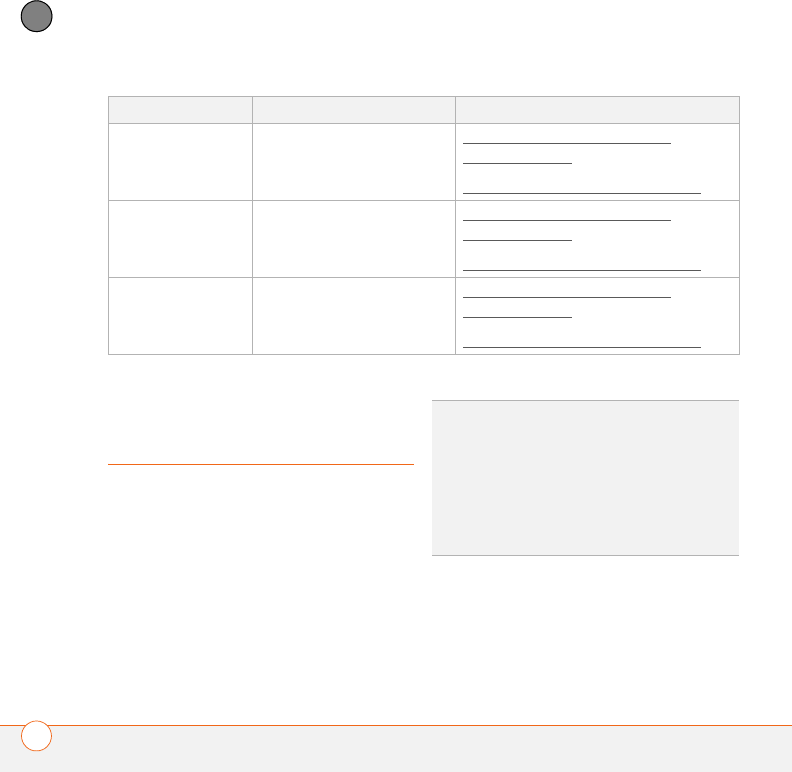
SYNCHRONIZING INFORMATION
SETTING UP WIRELESS SYNCHRONIZATION
70
4
CHAPTER
Setting up wireless
synchronization
Does your company use Microsoft Outlook
as its email solution? Does your company
also use Microsoft Exchange Server 2003
as its email server? If so, you may be able
to wirelessly synchronize the email and
other Outlook info on your smartphone and
the same info stored on the Exchange
Server using Microsoft Exchange
ActiveSync.
When the Exchange Server is upgraded to
Service Pack 2, you may be able to take
advantage of the additional features of
Direct Push Technology. Direct Push
Technology is a two-way wireless delivery
Pictures ActiveSync Setting up your computer for
synchronization
Changing which applications sync
Outlook Notes ActiveSync Setting up your computer for
synchronization
Changing which applications sync
Files to be
transferred to an
expansion card
ActiveSync Setting up your computer for
synchronization
Changing which applications sync
Info type Method Where to learn more
DID
YOU
KNOW
?
Because your desktop copy of
Outlook also syncs with the corporate server,
whatever is synchronized wirelessly to the
server from your smartphone also shows up
in your desktop copy of Outlook; and
whatever you enter or change in Outlook on
your computer syncs to the server and then
shows up on your smartphone.
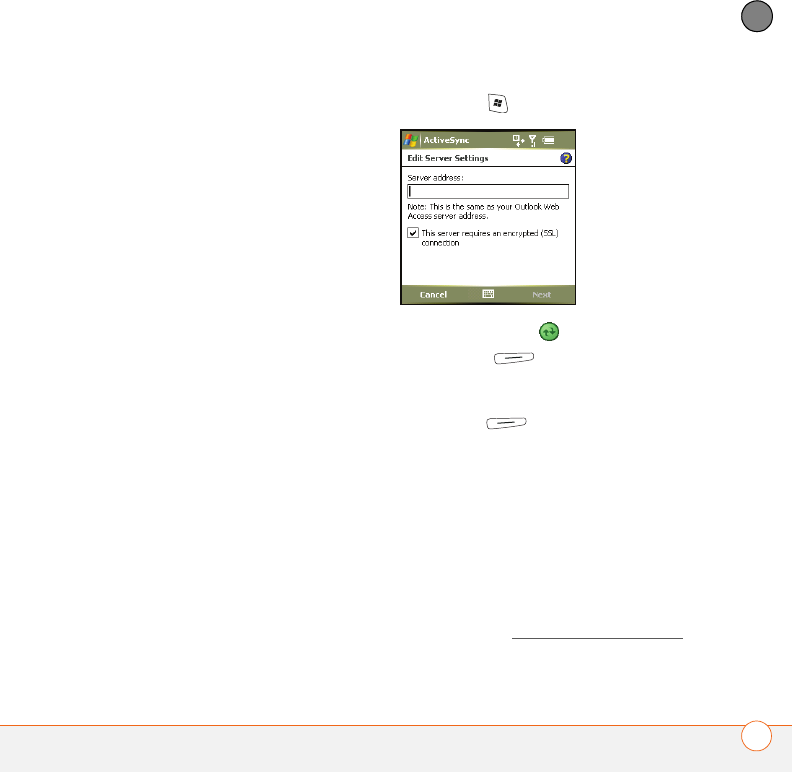
SYNCHRONIZING INFORMATION
SETTING UP WIRELESS SYNCHRONIZATION 71
4
CHAPTER
method that keeps your Outlook
information always up-to-date and provides
more efficient communication between the
server and your smartphone. It includes
features like Global Address List, Tasks
Over The Air (OTA), and IP-based push
updating of Calendar, Messaging, and
Email.
NOTE Even if you sync with an Exchange
Server, we recommend that you install
ActiveSync desktop software as well, to
take full advantage of your smartphone’s
capabilities.
To synchronize wirelessly, you need to set
up an Exchange Server Account. Work with
your system administrator to gather the
following info, and then follow the steps in
this section to set up an account.
•Mail server address and domain name
•The username and password you use to
access the corporate mail server
•Security connection: Does your server
use an encrypted (SSL) connection?
1Press Start and select Programs.
2Select ActiveSync .
3Press Menu (right action key)
and select Add Server Source.
4Enter the server address, and then
press Next (right action key).
5Enter the username and password you
use to access your corporate mail
server, and then enter the Exchange
Server domain. Check the box if your
server uses an encrypted connection.
You can’t see your password as you
enter it, so be careful. Be sure Caps
Lock and Option Lock are not on unless
you need them. For info on how to enter
characters, see Entering lowercase and
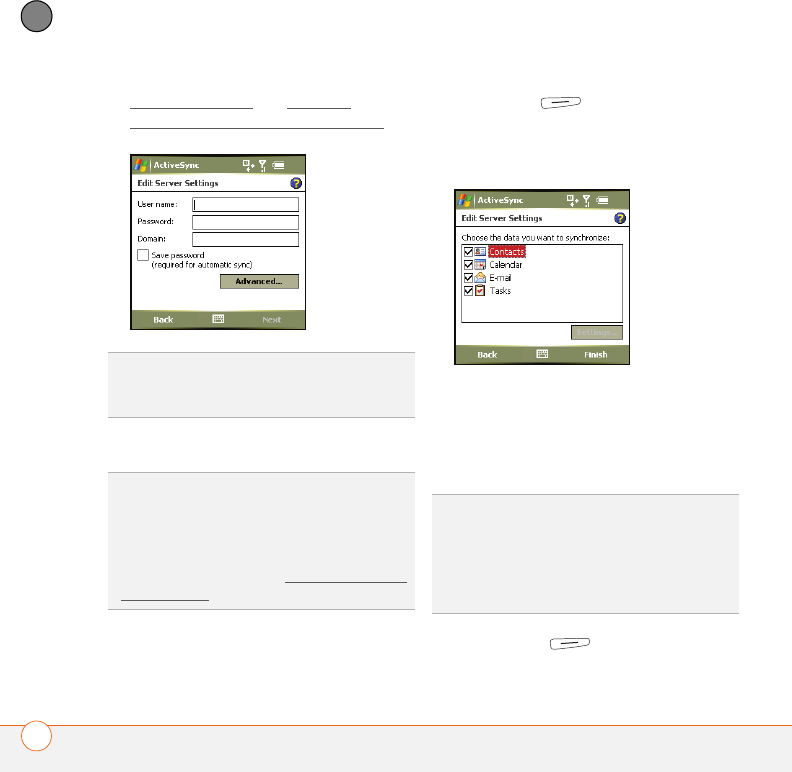
SYNCHRONIZING INFORMATION
SETTING UP WIRELESS SYNCHRONIZATION
72
4
CHAPTER
uppercase letters and Entering
numbers, punctuation, and symbols.
6Check the Save password box.
7(Optional) Select Advanced to set the
rules for fixing sync conflicts.
8Press Next (right action key) and
check the boxes for the types of
information you want to synchronize
with Exchange Server.
9(Optional) Highlight one of the items
and select Settings to change the
synchronization settings for that type
of information. Settings are not available
for all items.
10 Press Finish (right action key).
Synchronization with your Exchange
TIP
The Exchange Server settings are case-
sensitive. Be sure to enter uppercase and
lowercase letters properly.
TIP
Ask your system administrator if it is OK to
store your corporate email password on your
smartphone (for increased security, you may
need to enter your password each time you
access your email). If it is not OK, you must
synchronize manually (see Initiating a wireless
sync manually).
TIP
If you want to download more than the
email message header, select E-mail in step 9
and increase the KB setting. If you don’t
increase this setting, you can manually
download the rest of the message at your
convenience.